Standing watch over the great Trafalgar Square in London is the impressive column façade of The National Gallery of London. Inside these thick walls are over 2,300 treasures spanning 700 years of history. That number is staggering to read, and it can be overwhelming when you step inside, not knowing where to start. Personally, I think that many tourists, even those who love art, can’t see every single piece in the gallery without becoming overtired, causing the art to blend into background noise.
You see all those tired people on the benches? Some of them are there simply because they are overstimulated. Instead, with this National Gallery self-guided tour, I’ve curated the most important works and a few of my personal favourites. By following along, you can ensure you have a guide around the museum, but take things at your own pace and don’t get overwhelmed.

- Why Take a National Gallery Self-guided Tour?
- Admission to the National Gallery of London
- Map of Self-Guided Tour of the National Gallery of London
- Room 12: Hans Holbein the Younger, 'The Ambassadors'
- Room 14: Venus and Mars by Sandro Botticelli
- Room 9: Leonardo da Vinci, 'The Virgin of the Rocks'
- Room 15: Saint Michael Triumphs over the Devil by Bartolomé Bermejo
- Room 18: Samson and Delilah by Peter Paul Rubens
- Room 22: Rembrandt's A Woman Bathing in a Stream
- Room 25: Lucas Cranach the Elder, Cupid complaining to Venus
- Room 28: The Arnolfini Portrait by Jan van Eyck
- Room 27: The Ugly Duchess by Quinten Massys
- Room 29: Titian's Bacchus and Ariadne
- Room 30: The Toilet of Venus by Diego Velázquez
- Room 32: The Supper at Emmaus by Caravaggio
- Room 34: The Fighting Temeraire by Joseph Mallord William Turner
- Room 41: The Water-Lily Pond by Claude Monet
- Room 41: The Umbrellas by Pierre-Auguste Renoir
- Room 43: A Wheatfield with Cypresses by Vincent van Gogh
- Room 43: Bathers at Asnières by Georges Seurat
- Room 45: The Execution of Lady Jane Grey by Paul Delaroche
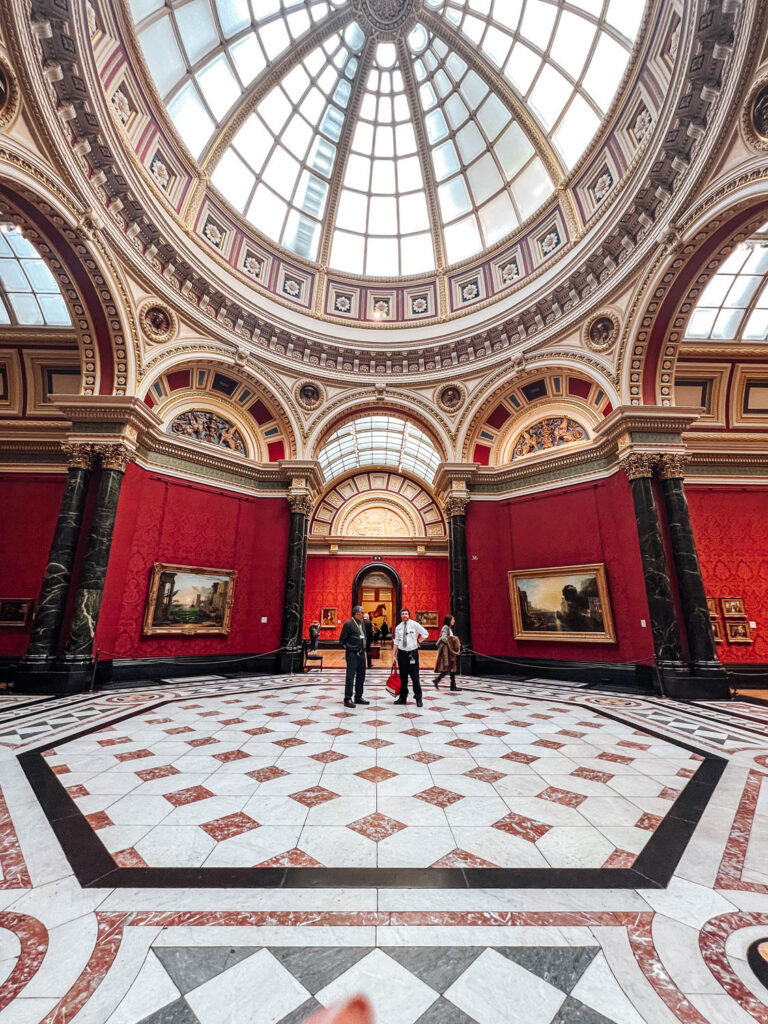
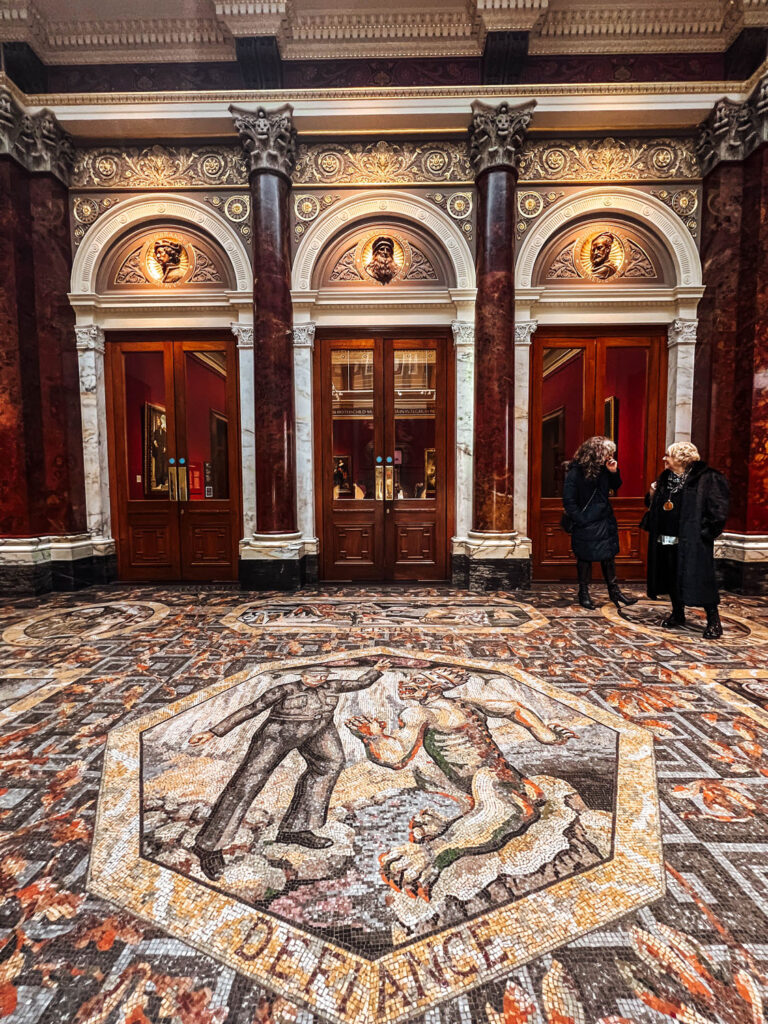
Why Take a National Gallery Self-guided Tour?
Even if you’re not in a rush, a self-guided highlights tour of the National Gallery allows you to efficiently explore the vast collection of over 2,300 pieces without feeling overwhelmed. A phenomenon called ‘museum fatigue‘ happens when we become mentally and physically exhausted due to the overwhelming number of exhibits and information in museums and galleries. This often leads to mental overload and a decreased ability to appreciate the art when we feel overstimulated and disengaged. However, a self-guided tour is short enough not to lose your interest, and being guided means you don’t need to make decisions after making decisions on where to go and what to see.
By focusing on the most notable and significant works, you can enjoy a personalized experience that allows you to spend more time with the art that captivates you. Plus, with the flexibility to control your pace and take breaks as needed, so you’ll avoid feeling lost or overstimulated. This tour will also provide insightful commentary to deepen your understanding while ensuring you maximize your visit. So, whether you’re an art enthusiast or just curious, a self-guided tour lets you explore the National Gallery!
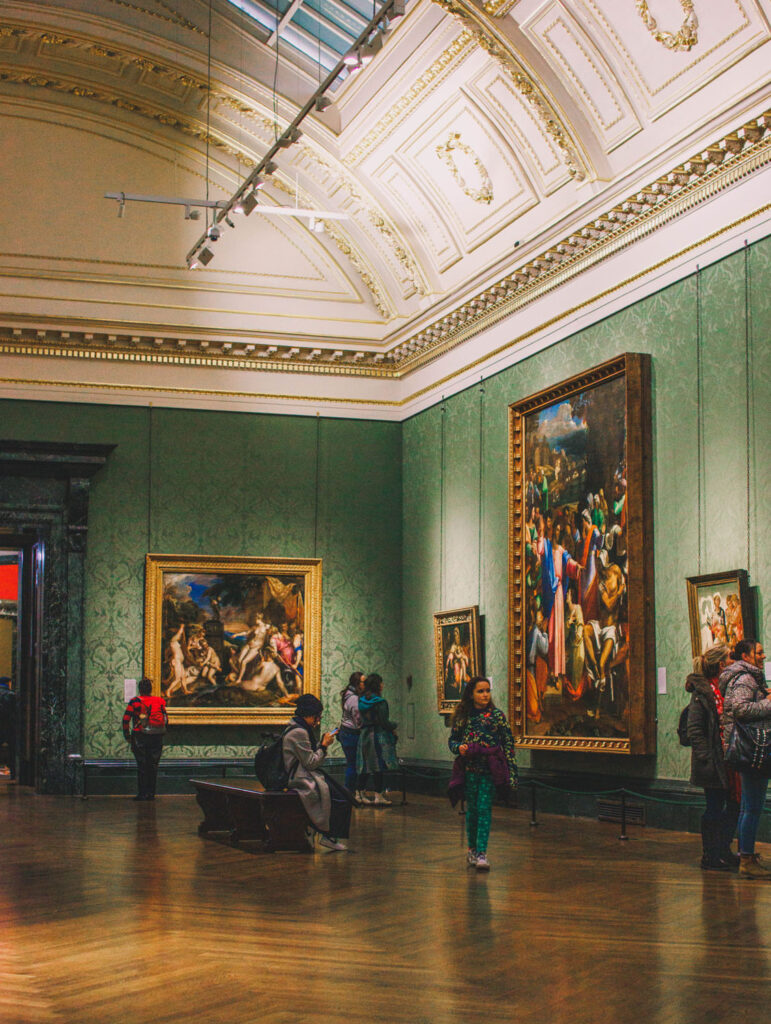
How Long Is This Tour?
This tour is designed to get you through the most important works inside the gallery in under two hours. This is the perfect amount of time and leaves enough wiggle room for you to branch off if you feel like exploring other works that catch your eye.
Do not be discouraged if any paintings are not on display during your visit. There is SO MUCH to see here, and if your favourite is missing, make it your mission to discover another new favourite!
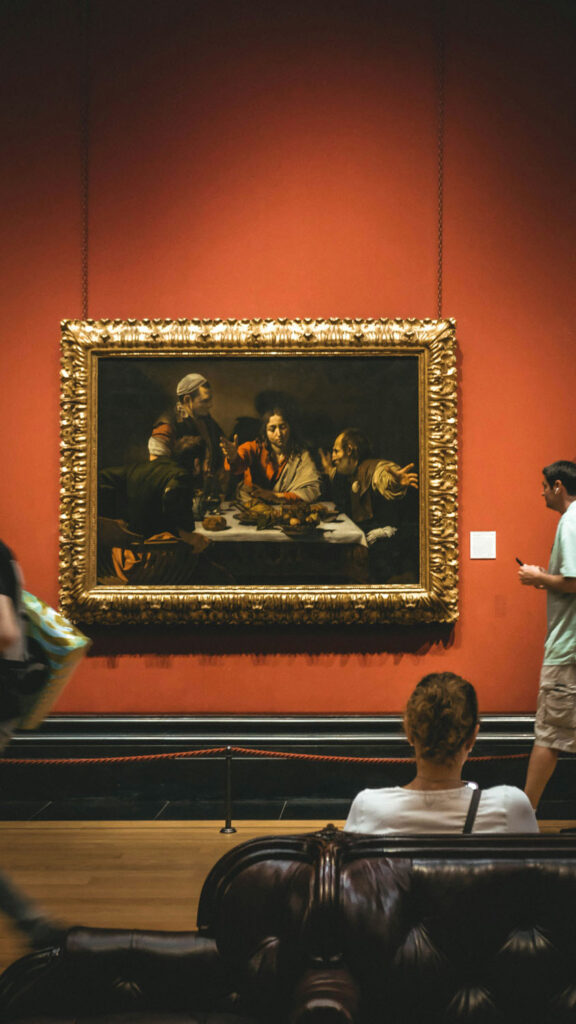
Admission to the National Gallery of London
Admission to the National Gallery in London is free, allowing visitors to explore over 2,300 paintings. Some special exhibitions may require paid tickets, but we won’t cover anything from those on our tour. My self-guided tours are always free, but you are more than welcome to buy me a coffee if you want to support this blog’s free content!
Despite the fact that entry is free, it is always recommended you still book your tickets in advance. You can still select the free option but by doing this, you can skip the long queue and guarantee your entry to the museum as some days frequently fully-book up in advance and you will not be able to get inside.
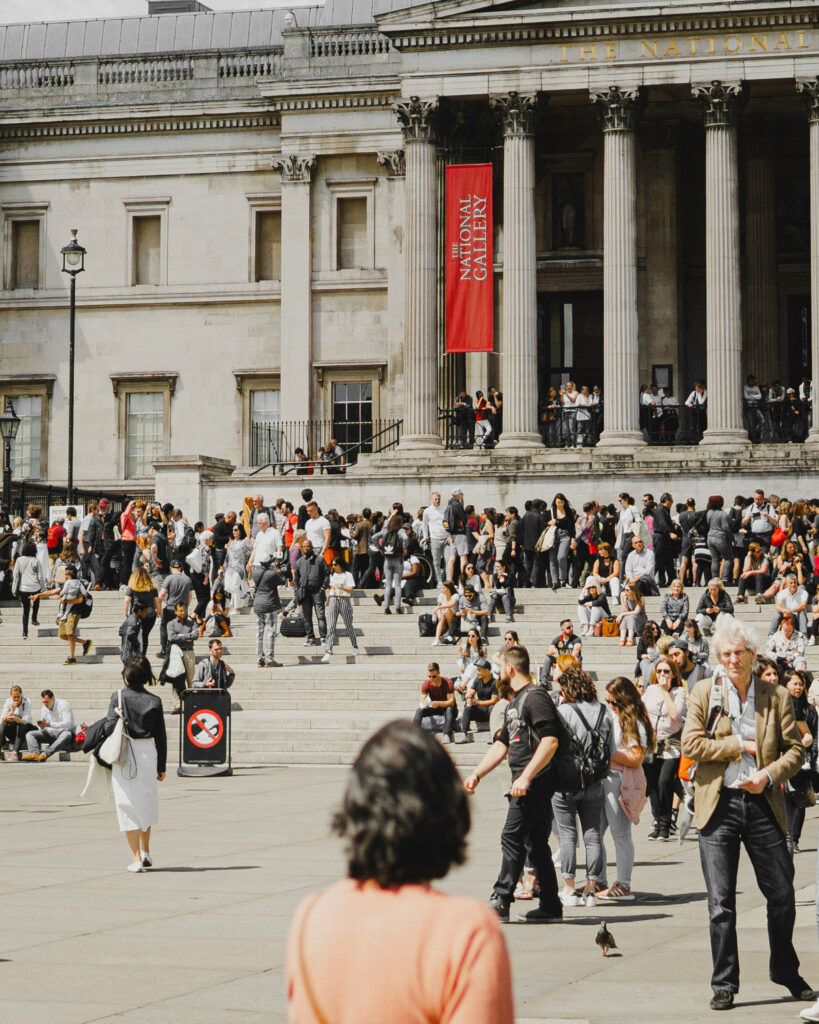
Map of Self-Guided Tour of the National Gallery of London

Enter via the Portico Entrance
Currently, visitors to the National Gallery in London enter primarily through the Portico Entrance, at the centre of the Gallery overlooking Trafalgar Square. As you step inside, you’ll be greeted by a stunning, sunfilled atrium that leads to a series of rooms, each filled with beautiful works of art. To start our tour, we will head into Room 12, just off to the left of the Central Hall. Inside this room, you’ll find one of the most enchanting and intriguing paintings of the 16th century, the ‘The Ambassadors’ by Hans Holbein the Younger, painted in 1533.
Room 12: Hans Holbein the Younger, ‘The Ambassadors’
The Ambassadors by Hans Holbein the Younger is a fascinating double portrait with intricate details and hidden meanings. In a room adorned with luxurious fabrics, two men stand side by side, exuding the confidence and wealth of the Renaissance elite. On the left is Jean de Dinteville, a French ambassador dressed in opulent furs and a striking pink satin doublet. On the right is his companion, Georges de Selve, a bishop and ambassador who wears a more sombre yet elegant robe.
In front of them is a meticulously arranged table showcasing their intellectual interests and items popular in the Renaissance era. The upper shelf displays instruments related to astronomy and timekeeping, symbolizing their quest for knowledge and the celestial realm. Below, the lower shelf holds musical instruments, a lute with a broken string, and an open hymn book, hinting at the fragility of harmony in music and life.
But wait, there’s a twist! At the bottom of the painting lies an odd, elongated shape that is difficult to discern. But when viewed from the right angle, it reveals itself as a skull—a stark reminder of mortality cleverly hidden through anamorphosis. This skull, along with a crucifix partially obscured in the upper left corner, contrasts the opulence of the scene and reminds viewers of the transient nature of earthly pleasures.
Holbein masterfully uses perspective and symbolism to infuse the painting with layers of meaning. The globe in the painting is so detailed that it reveals Jean de Dinteville’s estate in Polisy, France, and the lute’s broken string is often interpreted as a symbol of religious discord during the Reformation.
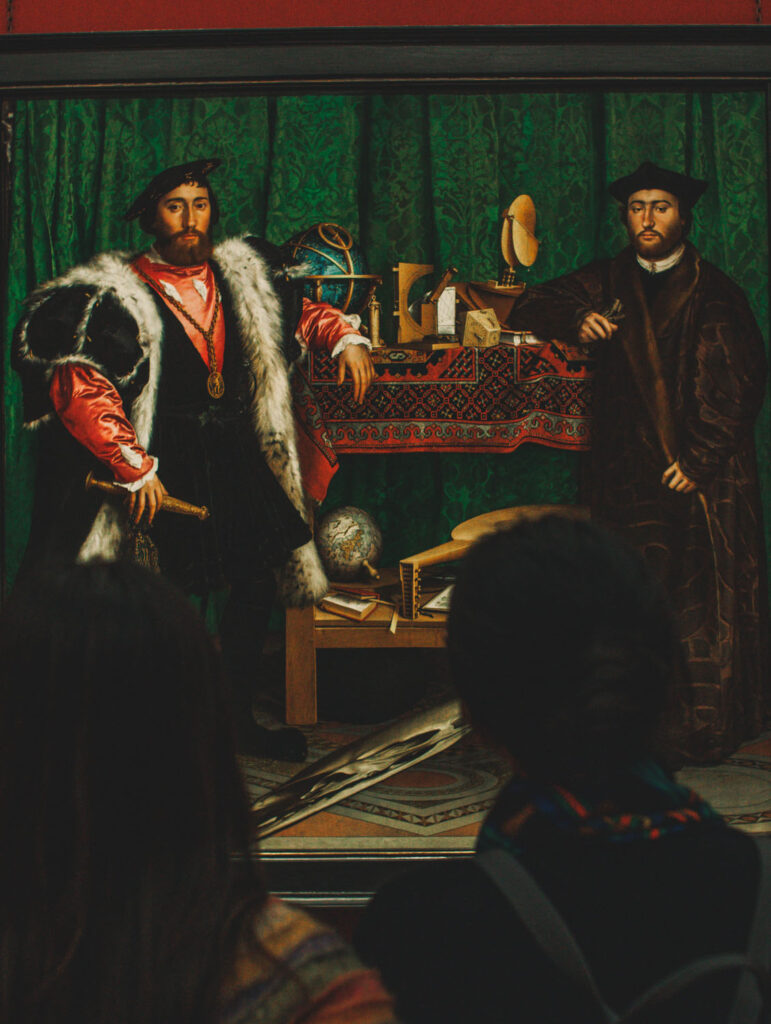
Room 14: Venus and Mars by Sandro Botticelli
Make a quick stop inside Room 14, where you can find the stunning sensuous Venus and Mars by Sandro Botticelli. Venus, the goddess of love, reclines languidly on a grassy bank, her serene expression radiating tranquillity as she gazes across at Mars, the god of war. Mars, overcome by sleep, lies opposite her with his armour carelessly discarded around him, exposing his muscular body. He is utterly at peace, a stark contrast to his usual fierce demeanour, subdued by the power of love.
Venus is elegantly draped in flowing white fabric that cascades around her, accentuating her graceful form. Her long, golden hair tumbles down her shoulders, catching the soft light and adding a touch of warmth to the composition. Her gaze is calm yet commanding, suggesting her mastery over Mars, depicted in a dreamy vulnerability.
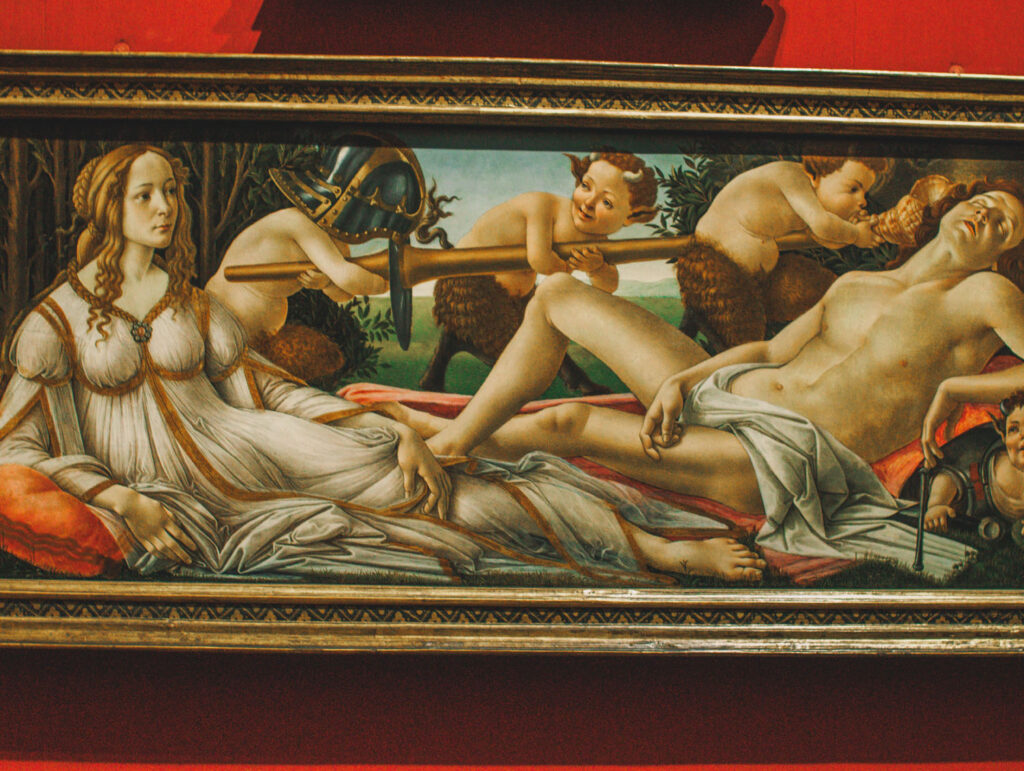
In the foreground, a group of mischievous satyrs plays with Mars’s armour, one trying on his helmet while another blows into his conch shell like a trumpet, amusing themselves in the god’s slumbering presence. These playful figures add a whimsical touch to the scene, symbolizing the folly of war and the triumph of love.
Venus and Mars were likely commissioned to celebrate a wedding, and the theme of love conquering all would have resonated with newlyweds of the time. The laurel tree in the background and the myrtle plants near Venus are symbols of fidelity and everlasting love, while the satyrs’ playful antics suggest the joys and challenges of marital life.
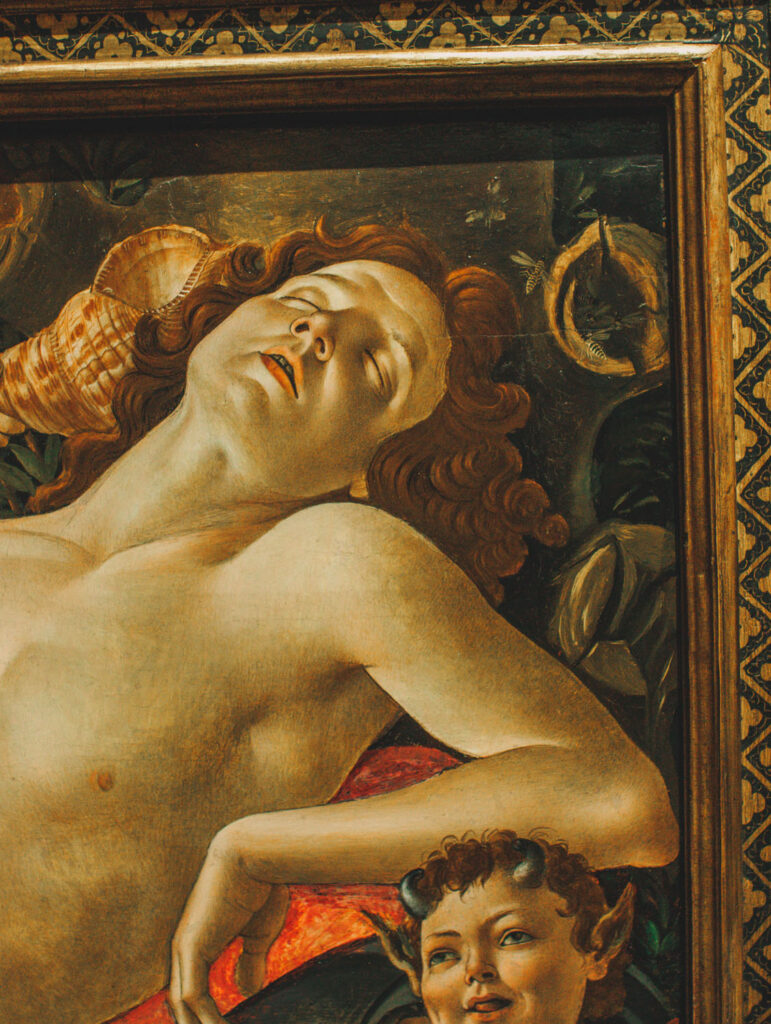
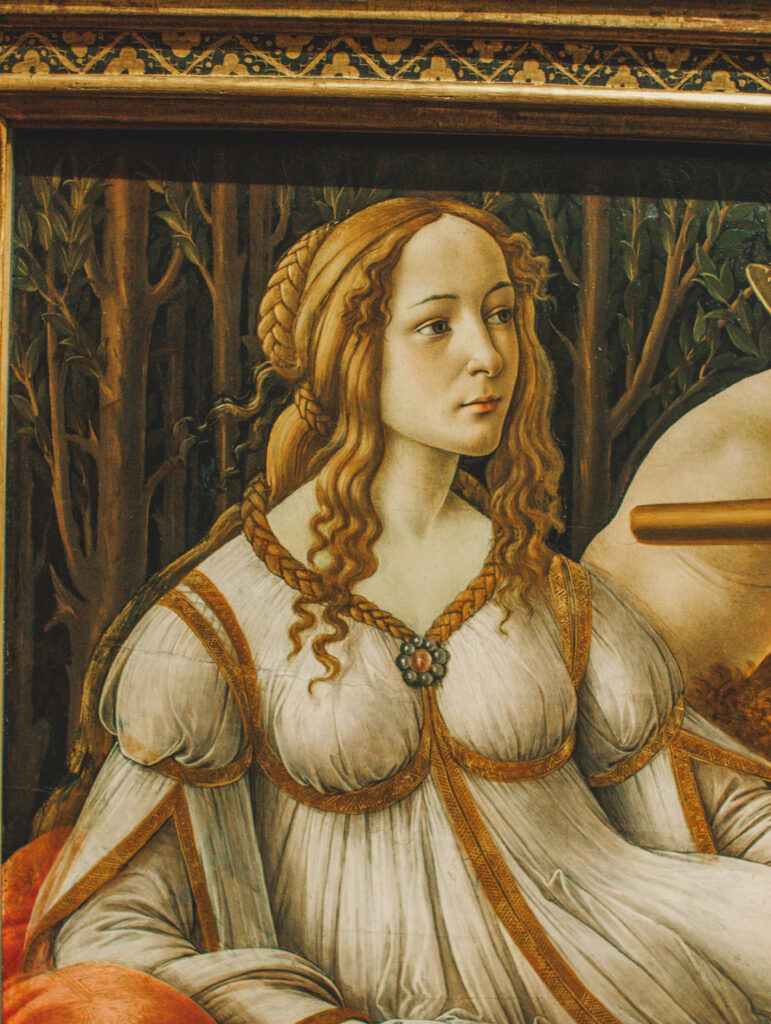
Room 9: Leonardo da Vinci, ‘The Virgin of the Rocks’
Continue walking west towards Room #9, where, during the closure of the Sainsbury Wing, you’ll find Leonardo da Vinci‘s The Virgin of the Rocks. This painting, completed in the late 15th century, is a masterpiece of Renaissance art. Leonardo da Vinci transports viewers into an enchanting, mystical grotto where the divine and the natural intertwine. A shadowy cave is bathed in a soft, ethereal light. In the center, the Virgin Mary sits gracefully, her serene face framed by cascading waves of auburn hair. She reaches out to embrace an angelic infant, John the Baptist, who gazes up with adoration at the Christ Child beside her. Jesus, with one hand raised in blessing, looks playfully at John while an angel to the right gently gestures toward them.
The rocky backdrop, lush with ferns and flowers, leads your eye to distant peaks that shimmer in the twilight haze. You can almost hear the trickle of water as it cascades down the moss-covered cliffs, adding a touch of magic to the scene. Using sfumato, Leonardo’s signature blending technique gives the painting a dreamy, soft-focus quality that brings the figures to life. And then there’s the symbolism. The cave itself is thought to represent the Virgin Mary’s womb, while the figures’ careful positioning forms a perfect triangular composition, symbolizing the Holy Trinity. The angel, identified as Uriel, serves as a celestial guide, his enigmatic smile inviting us into the sacred mystery.
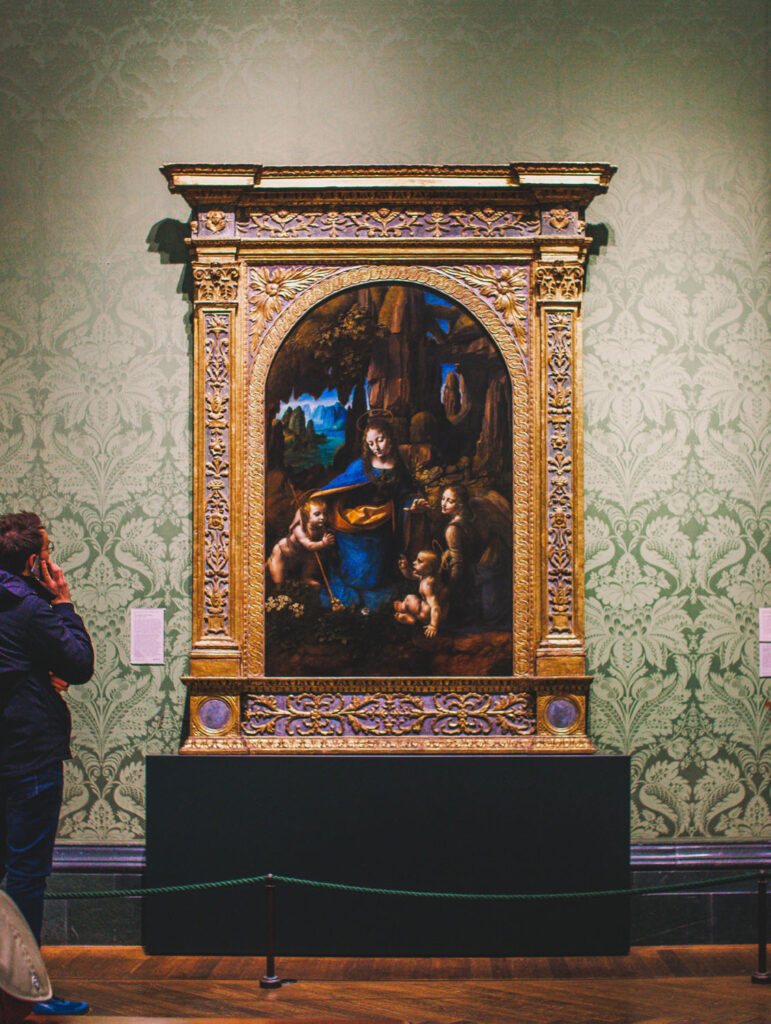
Variations on the Painting
But here’s a fascinating twist: The Virgin of the Rocks has two versions. The one hanging in the National Gallery is thought to be the second version, painted by Leonardo and his assistants after a dispute with the Confraternity of the Immaculate Conception over the original, which resides in the Louvre. Despite the controversy, both versions share the same ethereal beauty and attention to detail. In the National Gallery version, the angel Uriel’s right hand initially pointed directly at John the Baptist in a gesture of recognition, but Leonardo later altered this detail to make the composition more subtle and mysterious.

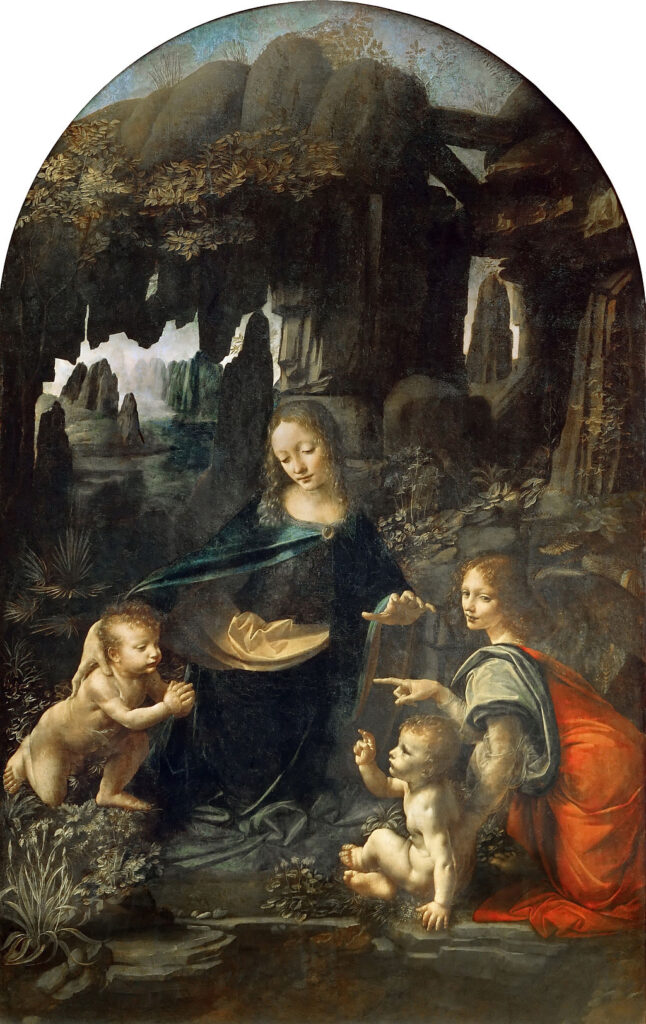
Room 15: Saint Michael Triumphs over the Devil by Bartolomé Bermejo
Walk north into Room 15; I love to bring people to study Bartolomé Bermejo’s Saint Michael Triumphs over the Devil. Saint Michael Triumphs over the Devil by Bartolomé Bermejo is a dazzling display of medieval imagination and gothic grandeur that whisks you away to a world of celestial battles and divine triumphs. In a richly detailed scene, Saint Michael stands imposingly atop a writhing, grotesque devil, his polished armour gleaming like molten gold in the sunlight. His wings unfurl behind him, a radiant and shimmering rainbow of colours.
Saint Michael’s expression is one of calm determination as he raises a delicate yet formidable sword, preparing to deliver the final blow to his snarling foe. The Devil beneath him is a terrifying fusion of reptile and demon, with scales, horns, and bulging eyes that dart frantically in all directions. Bermejo’s meticulous brushwork brings this nightmarish creature to life, making you almost feel its desperate struggle against the saint’s unwavering might.
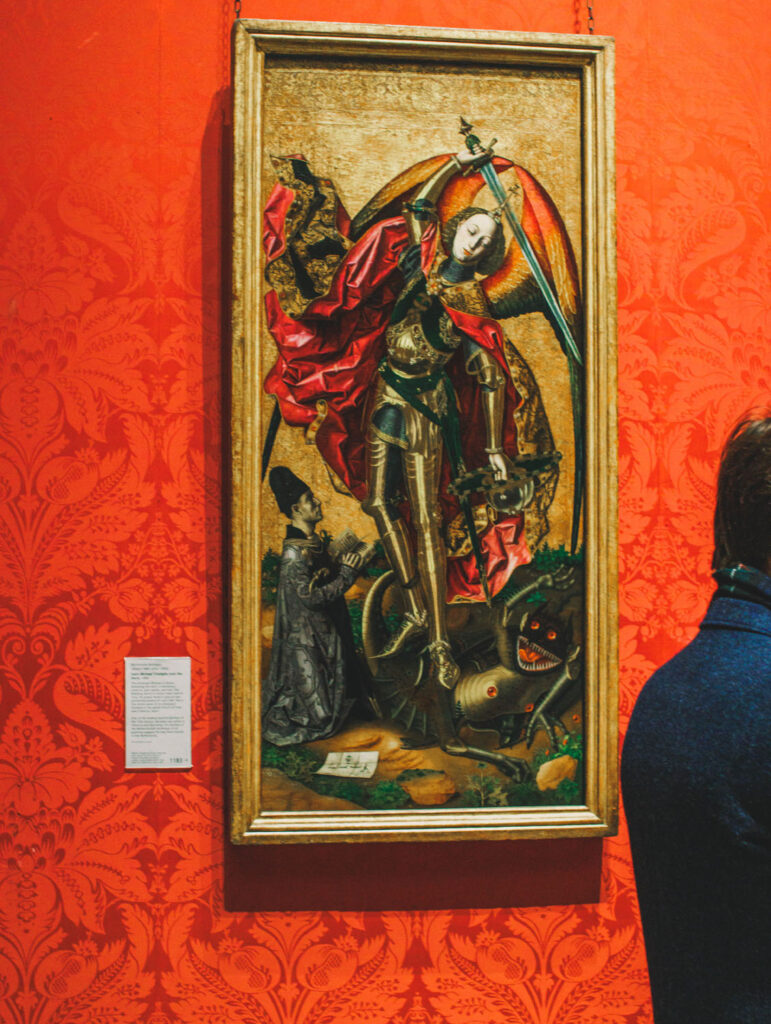
The Tiny Details
Look closely at the saint’s breastplate, and you’ll see exquisite reflections of the holy city of Jerusalem as described in the Book of Revelation. The jewel-like colours and intricate patterns of his garments and armour reveal Bermejo’s unparalleled skill, influenced by Flemish painting but distinctly Spanish in style. The golden brocade glimmers with every movement as if the saint is caught between the material and spiritual worlds.
Bermejo painted Saint Michael’s Triumphs over the Devil for a merchant named Antonio Juan, who appears kneeling at the saint’s feet in prayer. His inclusion as a donor reflects the era’s tradition of combining devotional art with personal commemoration.
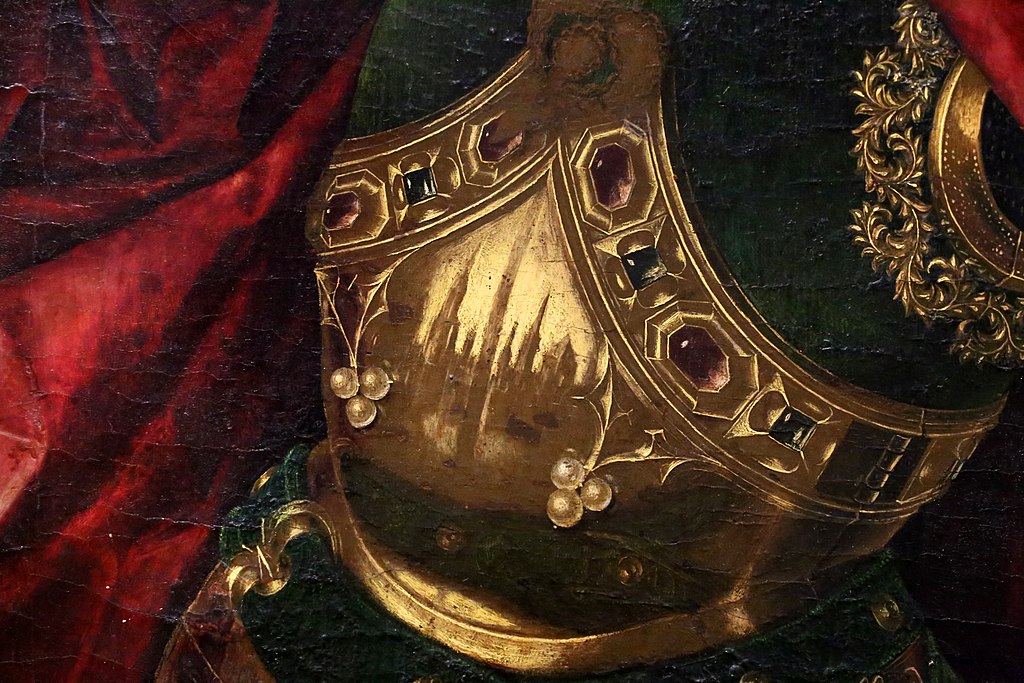
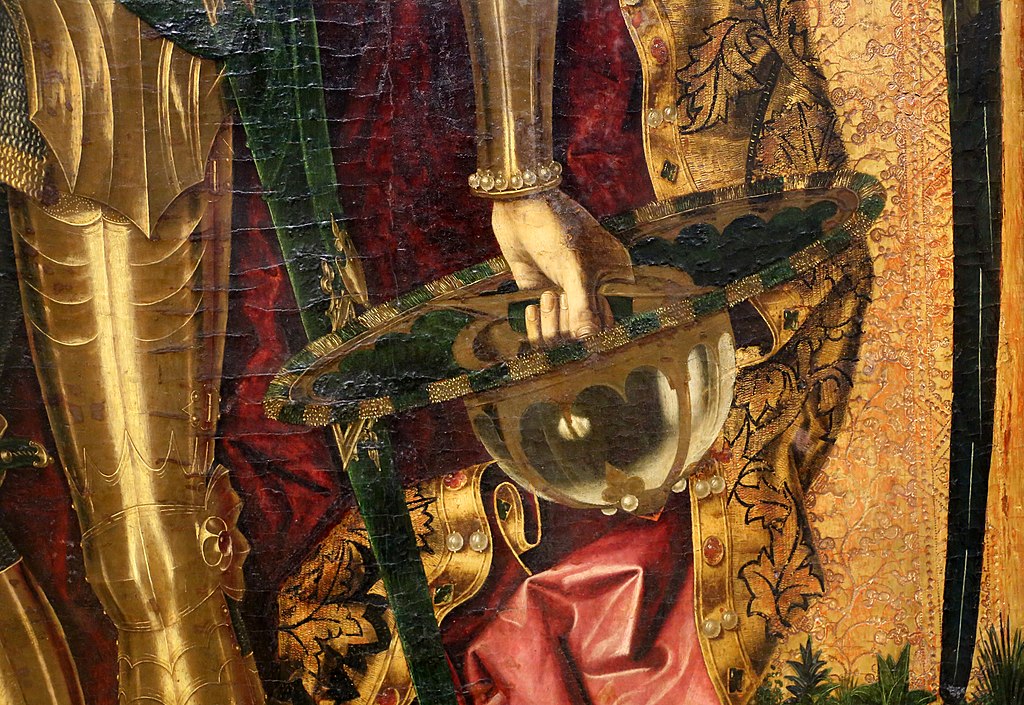
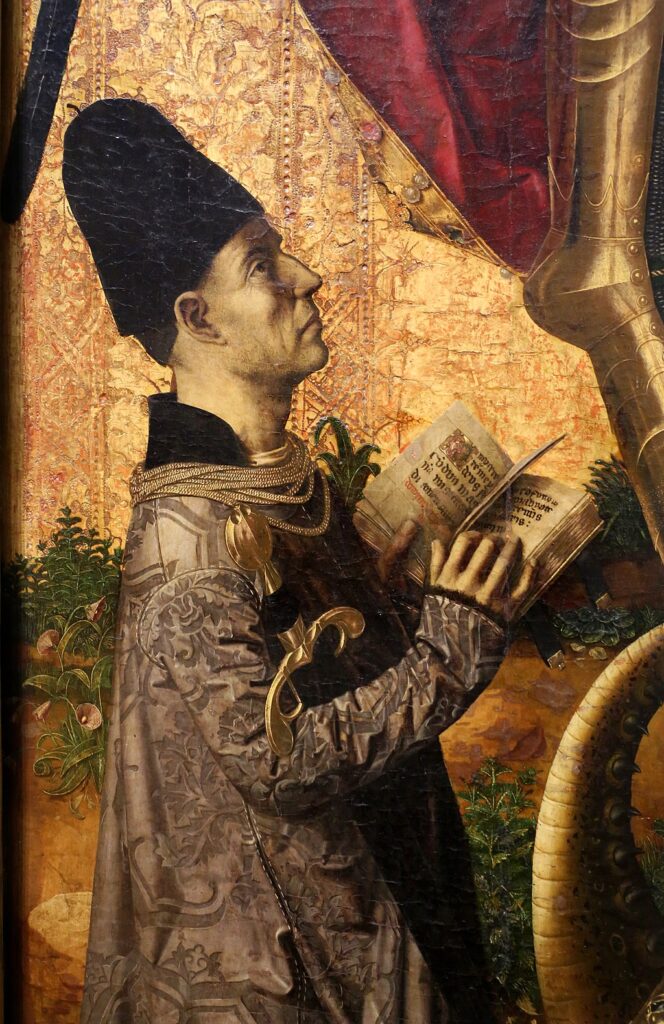
Room 18: Samson and Delilah by Peter Paul Rubens
Straight ahead, step into Room 18, where we can find several paintings by Peter Paul Rubens. Samson and Delilah by Peter Paul Rubens is a sumptuous masterpiece that immerses you in the dramatic climax of one of the Bible’s most infamous love stories. A dimly lit room, where the warm glow of a single candle casts dancing shadows on the crimson drapery and richly textured fabrics, is the chamber where lies the mighty Samson, slumped in Delilah’s lap, his muscular body glowing in the soft light as he drifts into a deep, wine-induced sleep. Delilah, draped in a lavish red satin gown that shimmers with golden highlights, looks down at Samson with a sly smile. Her expression is a mix of triumph and tenderness as she strokes his thick curls, signalling to an old woman beside her to cut his hair, the secret of his legendary strength. The old woman watches with a knowing gaze while a furtive barber crouches in the shadows, scissors poised to sever Samson’s fate.
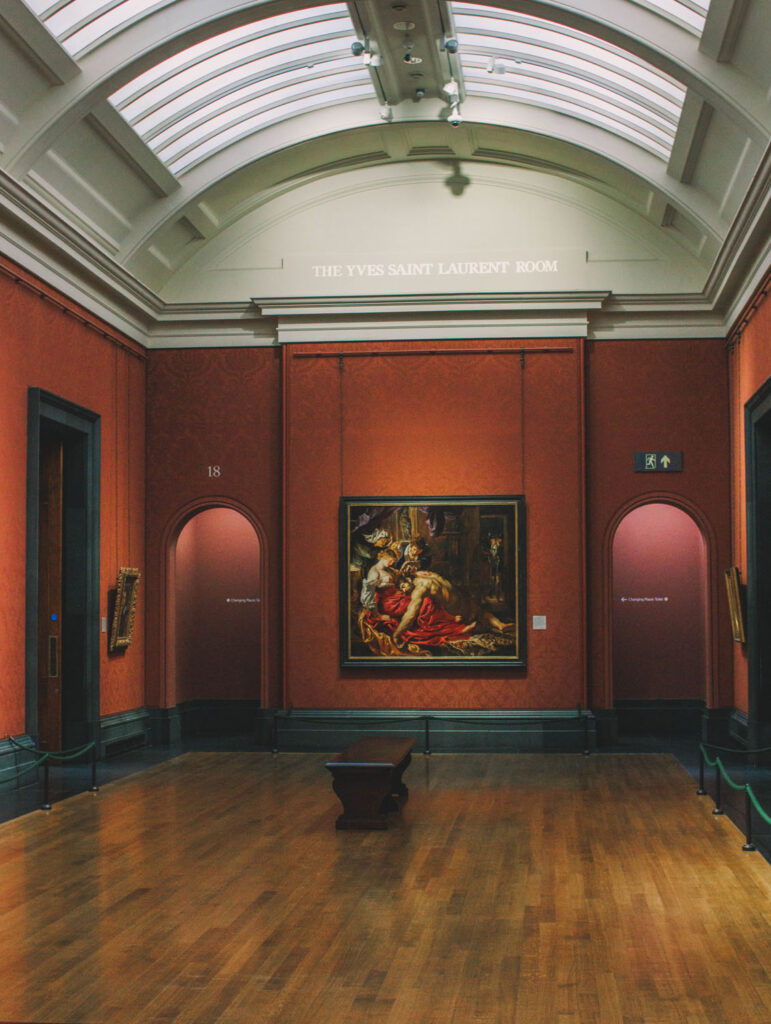
But the scene is far from peaceful. Behind the lovers, hidden in the deep shadows, soldiers armed with spears and helmets wait in anticipation, ready to capture the hero as soon as he is rendered powerless. Rubens brilliantly orchestrates this tense moment, balancing intimacy with looming danger, all within the rich, chiaroscuro palette that evokes the influence of Caravaggio. Rubens was inspired by Caravaggio’s The Taking of Christ and often borrowed motifs from the Italian master’s dramatic style. In Samson and Delilah, he paints Samson’s limp hand mirroring the composition of Michelangelo’s Creation of Adam on the Sistine Chapel ceiling, suggesting a loss of divine power.
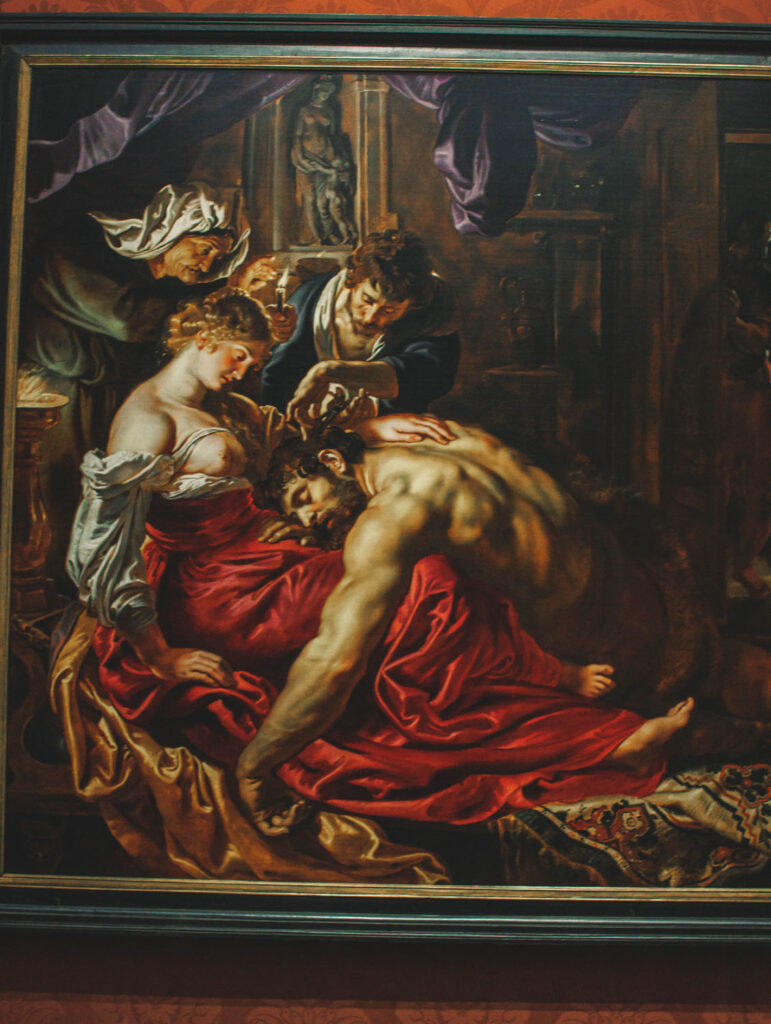
Room 22: Rembrandt’s A Woman Bathing in a Stream
The National Gallery features several famous Rembrandt’s, but Rembrandt‘s A Woman Bathing in a Stream is the most enigmatic to me. This quietly captivating painting invites you into an intimate and contemplative moment frozen in time. In the center stands a solitary woman, her head gently bowed as she lifts the hem of her white chemise, delicately dipping her toes into the cool, reflective water. Rembrandt’s mastery of chiaroscuro is on full display, with the woman bathed in a soft, golden light that contrasts beautifully against the dark, earthy tones of the surrounding foliage. Her youthful face is serene, a faint smile playing on her lips as if she’s caught in a moment of quiet reflection. The subtle blush on her cheeks and slightly furrowed brow convey an innocence and vulnerability that make her seem almost tangible.
The textures are mesmerizing: the delicate folds of her chemise ripple in the soft breeze, her loosely bound hair catches the evening light, and the water swirls gently around her feet. The way Rembrandt has captured the reflection in the stream and the dappled light on her skin adds to the painting’s lifelike quality. Rembrandt portrays the woman naturally, with a softness and realism that celebrates her humanity rather than idealizing her form. The result is a deeply personal and emotive work that transcends time.
The Mystery Woman
What’s particularly intriguing is the identity of the woman. Many believe she is Hendrickje Stoffels, Rembrandt’s companion and muse, who frequently appeared in his later works. Rembrandt painted this intimate piece around 1654 when he was deeply in love with Hendrickje and exploring new forms of expression. His tender attention to her features and posture reflects his affection and admiration for her. However, her simple attire and modest demeanour suggest she may represent a biblical figure, such as Susanna or Bathsheba. Rembrandt leaves this deliberately ambiguous, allowing viewers to interpret the scene through their own lens. The painting also stands out for its departure from classical ideals of beauty.

Room 25: Lucas Cranach the Elder, Cupid complaining to Venus
Make your way toward Room 25, which contains a myriad of paintings by Lucas Cranach, the Elder. My favourite from this collection is Cupid complaining to Venus due to the delightful and playful nature of this painting. Venus stands in a sunlit glade with towering trees, the epitome of beauty and grace, her delicate form glowing against the dark foliage. She wears nothing but a red, feathered hat and lavish necklace. Her relaxed pose and enigmatic smile hint at a serene confidence.
Beside her stands Cupid, her mischievous son, looking up at her with a pouty expression as he complains about the bees that have stung him after he tried to steal honey from their hive. He holds one hand up to show Venus his plight while she listens with an amused expression, her gaze slightly averted as if she’s in on a secret joke. The contrast between Cupid’s distress and Venus’s calm demeanour adds a touch of humour to the scene. The scene represents the tempting sweetness of love but reminds us that love often comes with a sting.
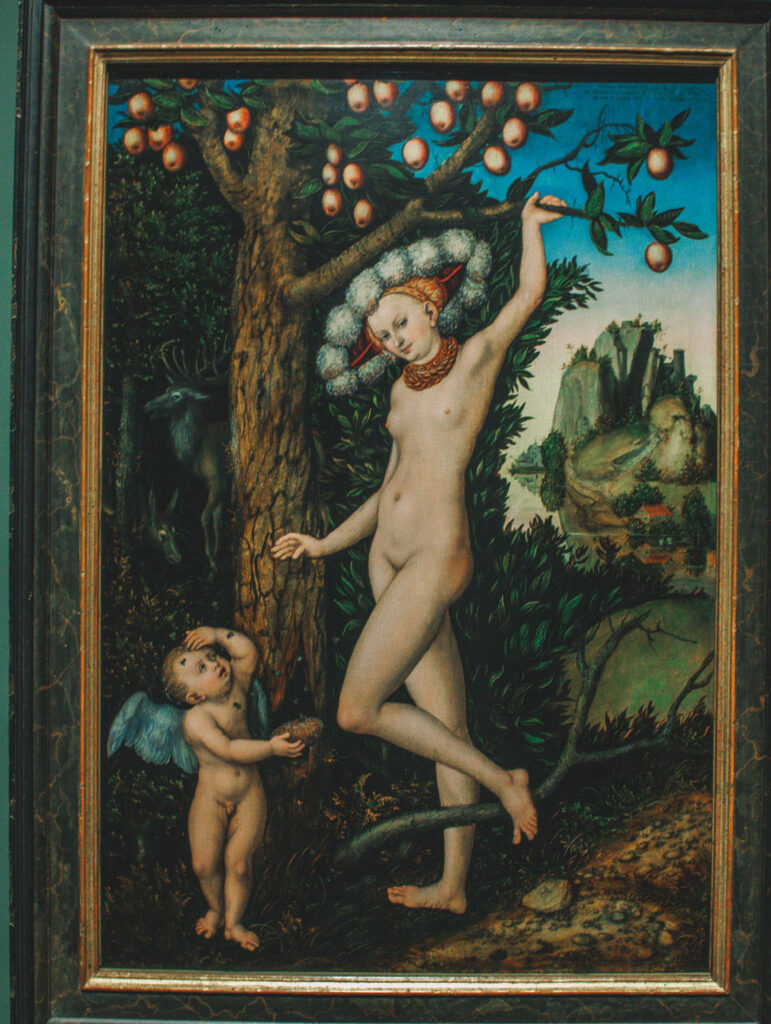
Room 28: The Arnolfini Portrait by Jan van Eyck
Directly below us is Room 28, which contains perhaps one of the most famous paintings in the entire world: The Arnolfini Portrait by Jan van Eyck. This painting is a mesmerizing glimpse into 15th-century life, brimming with symbolism and exquisite detail. We see a dimly lit, opulent room where every surface shimmers with textures and colours. In the center, a couple stands facing each other, frozen in time.
Giovanni di Nicolao di Arnolfini, a wealthy merchant, reaches out to grasp the delicate hand of his wife, believed to be Giovanna Cenami. His other hand is raised in a gesture of blessing or perhaps an oath.
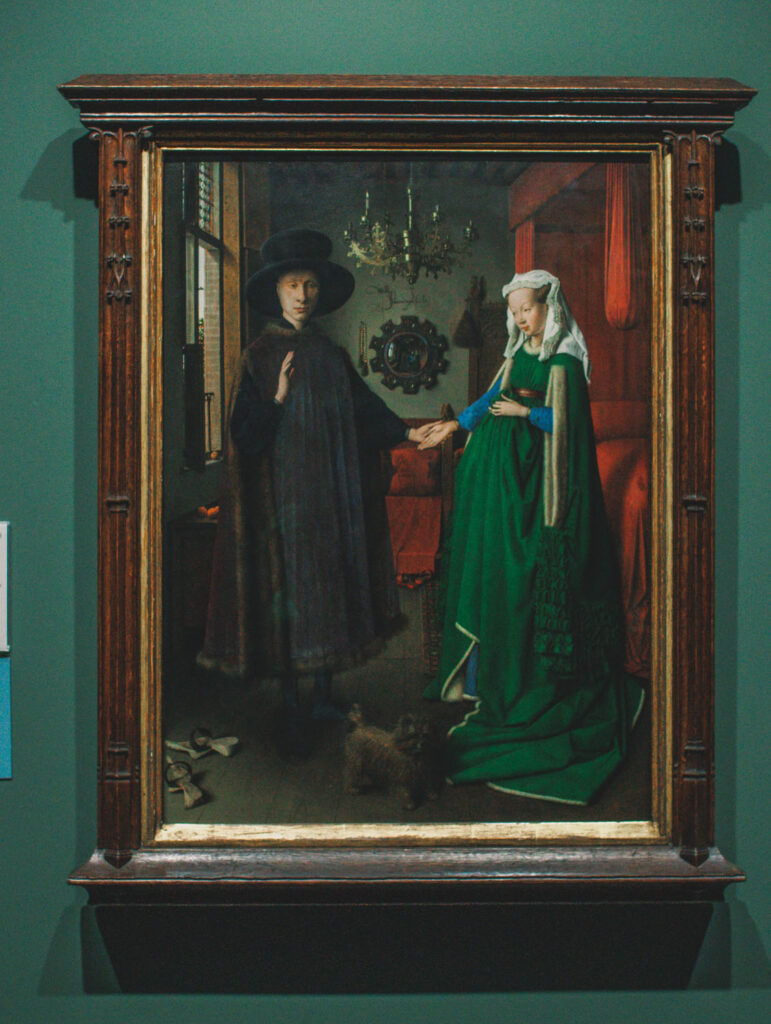
Giovanni wears a long, fur-lined robe in deep green, while Giovanna is adorned in a vibrant emerald gown, the fabric pooling luxuriously around her feet. Her high-waisted dress accentuates her rounded belly, hinting at pregnancy. Her hair is carefully coiffed under a white headdress, and a delicate gold chain rests around her neck. Both figures exude wealth and status. The painting has sparked countless interpretations, with scholars debating whether it depicts a wedding, a betrothal, or a double portrait. Whatever the meaning, it’s clear that Jan van Eyck wanted to immortalize this couple in a scene that feels almost cinematic in its composition and attention to detail.
Symbolism of the Room
But the room around them truly captivates viewers to this day. The intricately woven Oriental carpet, the brass chandelier, the carved wooden bedposts, and the sumptuous drapery all speak to the couple’s affluence. The convex mirror on the back wall is the pièce de résistance, reflecting the couple and two other figures entering the room, one of whom is thought to be the artist himself. Above the mirror, Jan van Eyck leaves his unmistakable signature in Latin: “Johannes de Eyck fuit hic 1434” (“Jan van Eyck was here 1434”).
The symbolism in the painting is rich and fascinating. The little dog at their feet symbolizes fidelity, while the single candle burning in the chandelier could represent the all-seeing eye of God or the sanctity of marriage. The ripe oranges on the windowsill and table hint at fertility and wealth, as exotic fruits were rare in Northern Europe back then.



Room 27: The Ugly Duchess by Quinten Massys
In Room 27, we find another famous painting, but unlike many others in the gallery that are famed for their beauty, this one is famed for its hideousness. An Old Woman (‘The Ugly Duchess’) by Quinten Massys is a captivating and curious portrait that grabs your attention with its exaggerated features and striking expression. Despite being called ugly, we must marvel at how the picture has been painted. The old woman stands facing slightly to the left, her broad, muscular shoulders covered by a light white, voluminous blouse contrasting sharply with her wrinkled, ruddy face. Her pursed lips give her an almost comical yet somewhat sympathetic expression. Her large headdress, a lavish horned bonnet draped in white linen, gives her a distinctive, nearly mythical appearance. She holds a delicate red rosebud in her right hand between her thumb and forefinger, an ironic symbol of love and beauty that contrasts starkly with her unconventional looks.
Massys exaggerates her features for satirical effect, giving her a prominent chin, wide jawline, and a wrinkled, weather-beaten complexion. Her sagging breasts and bulging eyes lend her an exaggerated, grotesque appearance reminiscent of a caricature. Despite her somewhat humorous portrayal, there’s an underlying melancholy in her eyes, revealing a depth of emotion beyond the surface. Some speculate that she may have been afflicted with Paget’s disease, a condition that affects bone growth, further enhancing the grotesque distortion of her features.
Inspiration for Alice in Wonderland
Massys originally painted this as part of a double portrait, paired with a companion piece that featured an older man in a matching caricature style. This pairing hinted at a satirical message about love and vanity in old age. The Duchess’s story is also linked to the tale of Alice in Wonderland, where she inspired John Tenniel’s illustrations of the Ugly Duchess character. Her distinct appearance and exaggerated features have made her an iconic figure in art history, representing the intersection of satire, beauty, and societal norms.
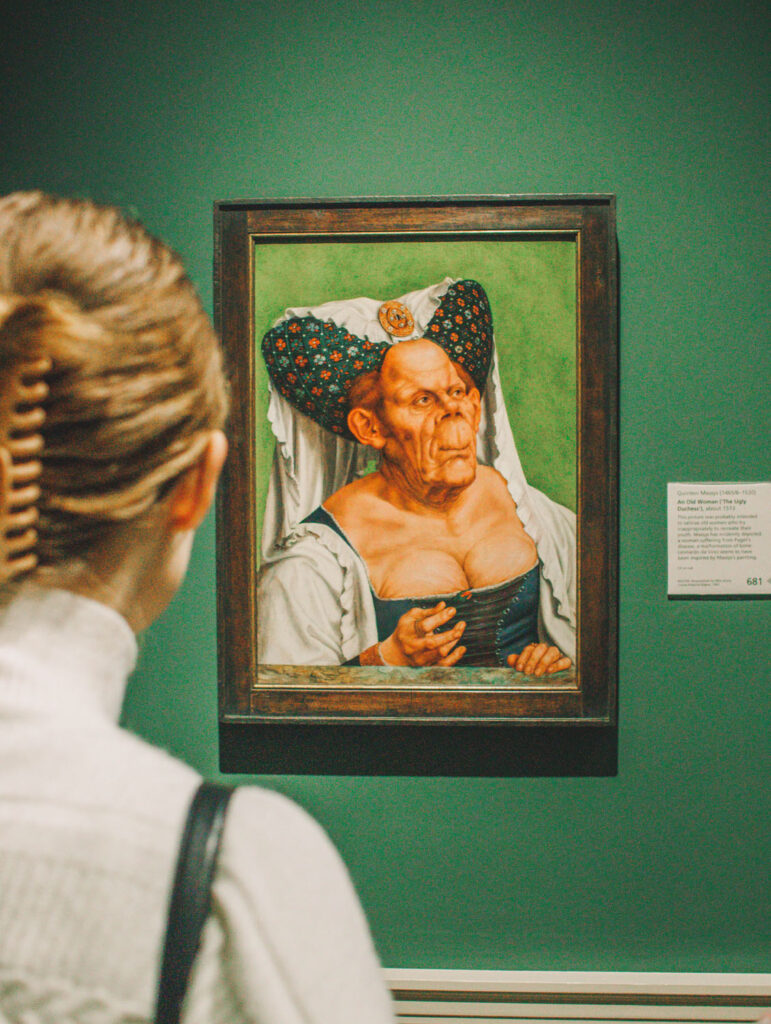
Room 29: Titian’s Bacchus and Ariadne
Moving back down to Room 29, let’s approach Titian‘s fantastical portrayal of the myth of Bacchus and Ariadne. This vivid and dynamic masterpiece brings the mythological story of love and transformation to life. Bacchus, the god of wine, with his crowned wreath of ivy and leopard skin draped across his body, leaps gracefully toward Ariadne from his golden chariot, his eyes locked on her with unwavering passion.
Ariadne stands on the shore, her gaze fixed in surprise and awe at Bacchus, who has fallen in love with her at first sight. Draped in a flowing azure cloak, she raises one hand in shock while the other clutches her rich red and blue robe. Her golden hair catches the sunlight, and her skin glows against the vivid colours of the sky and sea.
The frenzy of his retinue follows close behind, creating a swirling vortex of revelry. Satyrs and maenads dance ecstatically, their bodies twisting and turning in celebration. One satyr drags a cow’s head, while another, barely visible in the shadows, holds a writhing snake. A pair of cheetahs pulls Bacchus’s chariot, adding an exotic touch to the scene. The scene is bathed in a warm Mediterranean light, illuminating the turquoise sea and the rugged coastline in the background.
Every inch of the canvas bursts with energy and movement, making you almost feel the thundering hooves and swirling drapery. The composition is carefully balanced, with Ariadne’s figure anchoring the left side while the frenetic procession cascades across the right. The cheetahs pulling Bacchus’s chariot symbolize his exotic and wild nature, while the dancing satyrs and maenads embody the spirit of uninhibited revelry.
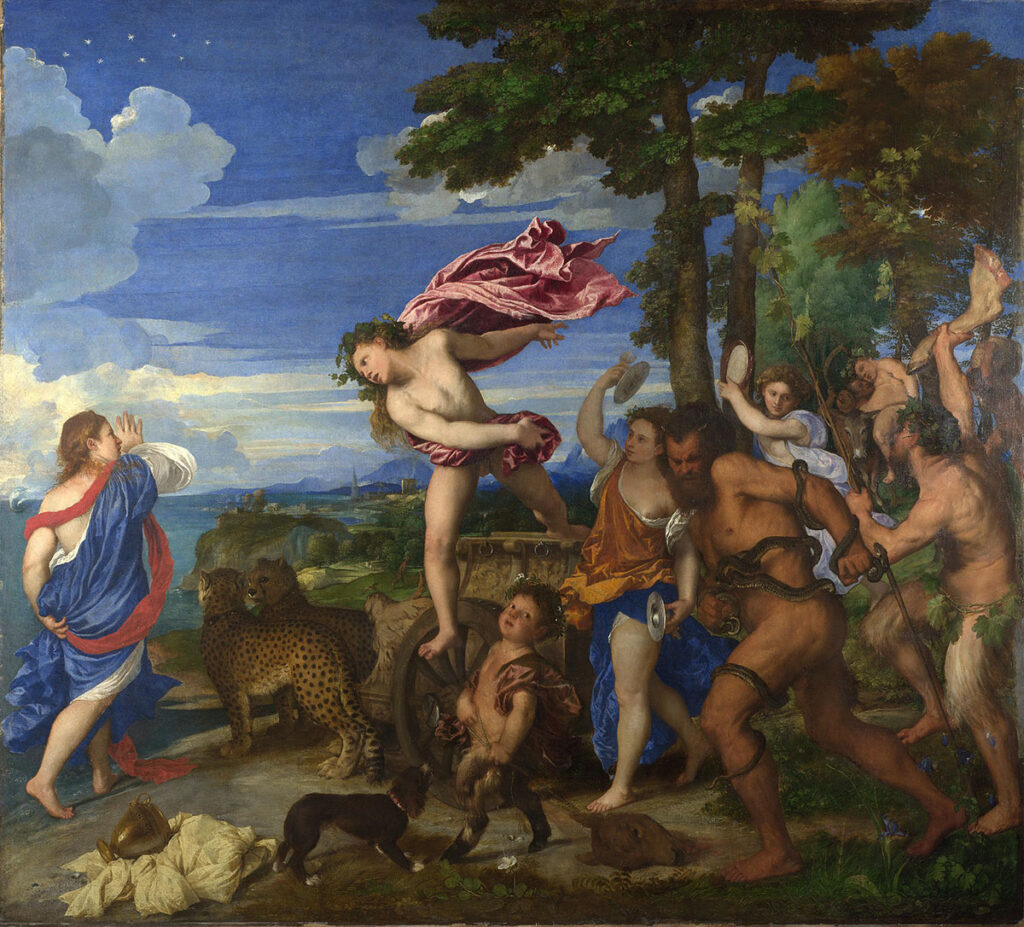
Room 30: The Toilet of Venus by Diego Velázquez
Walking towards the east, we step into Room 30, which contains The Toilet of Venus by Diego Velázquez. This is an exquisite exploration of beauty and sensuality, inviting viewers into a serene and intimate moment. The word “toilet” might not seem immediately like something that could evoke sensual tranquillity, but we have to consider the historical context of the painting. During the period in which this was painted, the term “toilet” comes from the French word toilette, which means “little cloth” or “dressing table.” The goddess Venus reclines gracefully on a luxurious bed, her supple, alabaster skin contrasting beautifully with the rich, crimson satin sheets beneath her. The fabric draped around her waist accentuates her delicate curves, adding a touch of modesty to the otherwise sensual scene.
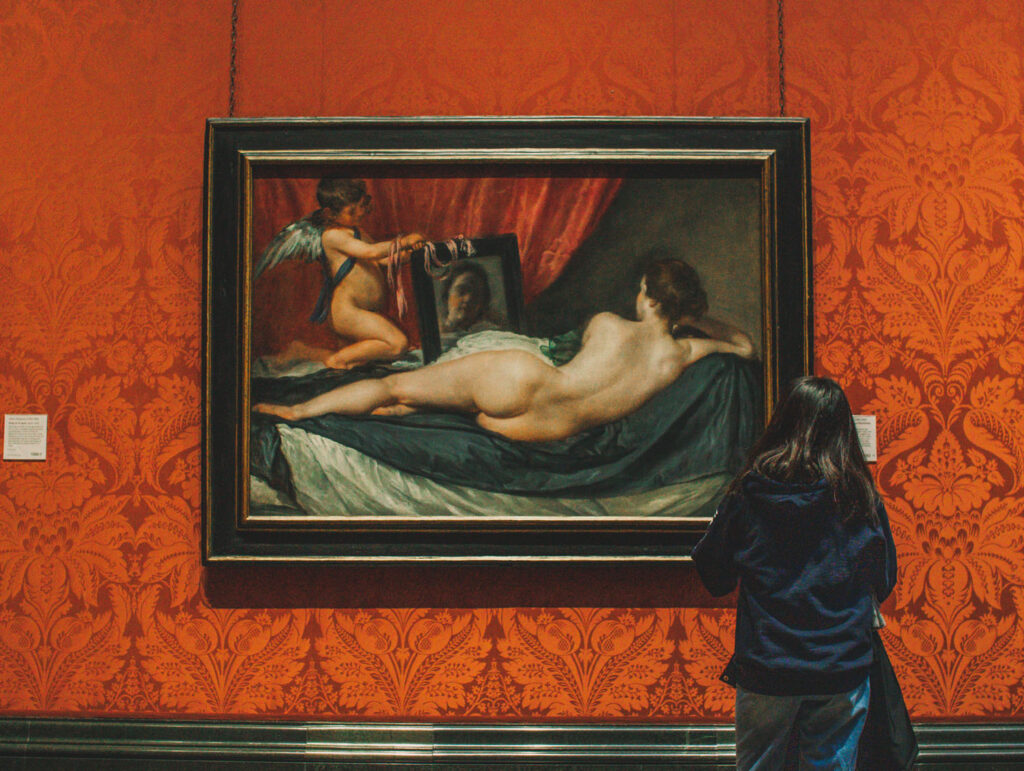
Cupid, with his rosy cheeks and tousled curls, holds up a mirror for his mother, his wings slightly outstretched as if caught in mid-flutter. The mirror captures Venus’s blurred reflection, her gaze meeting ours through the glass with a serene and enigmatic expression. The subtle twist of her lips and the soft blush on her cheeks suggest a playful yet confident awareness of her beauty.
The composition is beautifully balanced, with the deep reds of the bedspread contrasting against the cool, neutral tones of Venus’s skin. The dark background enhances the luminous quality of her figure, while the delicate interplay of light and shadow gives her an almost ethereal glow. The painting is often called The Rokeby Venus because it once belonged to the Rokeby Park estate in England. It is also one of the few surviving nude paintings by Velázquez, a rarity in Spanish art of the time due to strict moral and religious codes.
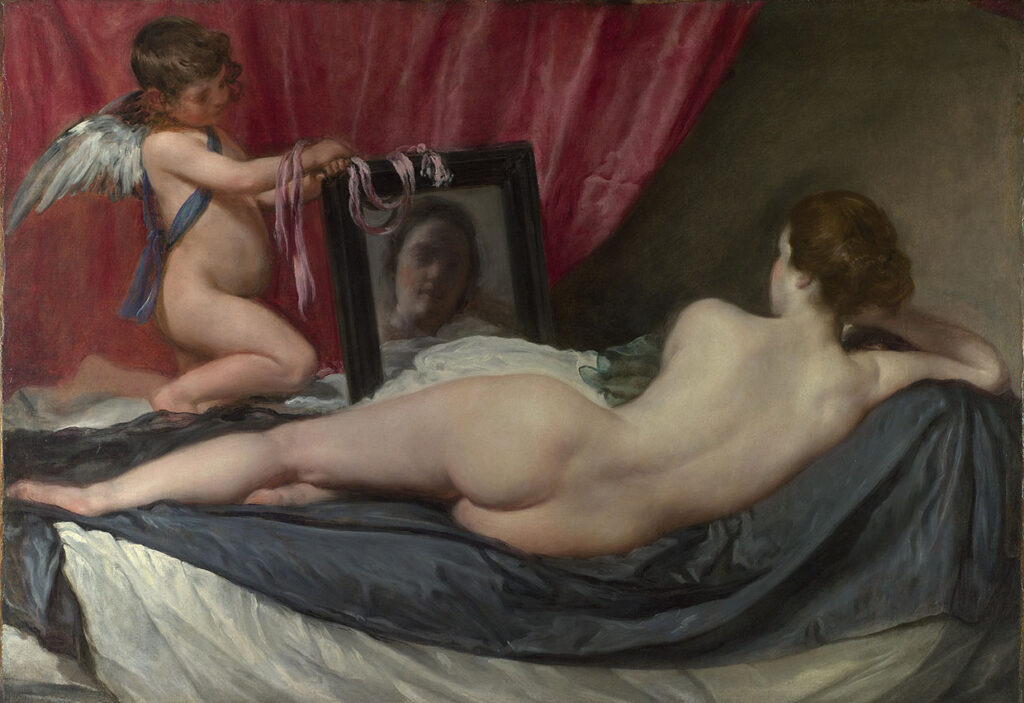
Room 32: The Supper at Emmaus by Caravaggio
In the next room, framed on the rich red walls, is Caravaggio‘s masterpiece, The Supper at Emmaus. Christ sits at the center of a rustic table just as he reveals his identity to two disciples. Their expressions are a mix of astonishment and disbelief, capturing the moment they recognize him. Christ, dressed in a simple white tunic and deep red robe, raises his right hand in blessing over the bread. His serene yet commanding presence contrasts with the disciples’ startled reactions.
On the left, one disciple leans back in shock, his mouth open in amazement as he clutches the arm of his chair, while the other disciple, on the right, throws his arms wide in disbelief, almost knocking over a bowl of fruit. Their gestures and expressions are so lifelike that you can practically hear their gasps. In front of Christ sits an innkeeper, who watches the scene with a puzzled expression, oblivious to the miracle unfolding before him.
The table has simple yet symbolic fare, including a roasted chicken and fruit basket. The latter includes a pomegranate, symbolizing resurrection, and an apple, representing original sin. The fruit teeters precariously on the edge, suggesting the fragile line between the earthly and the divine.
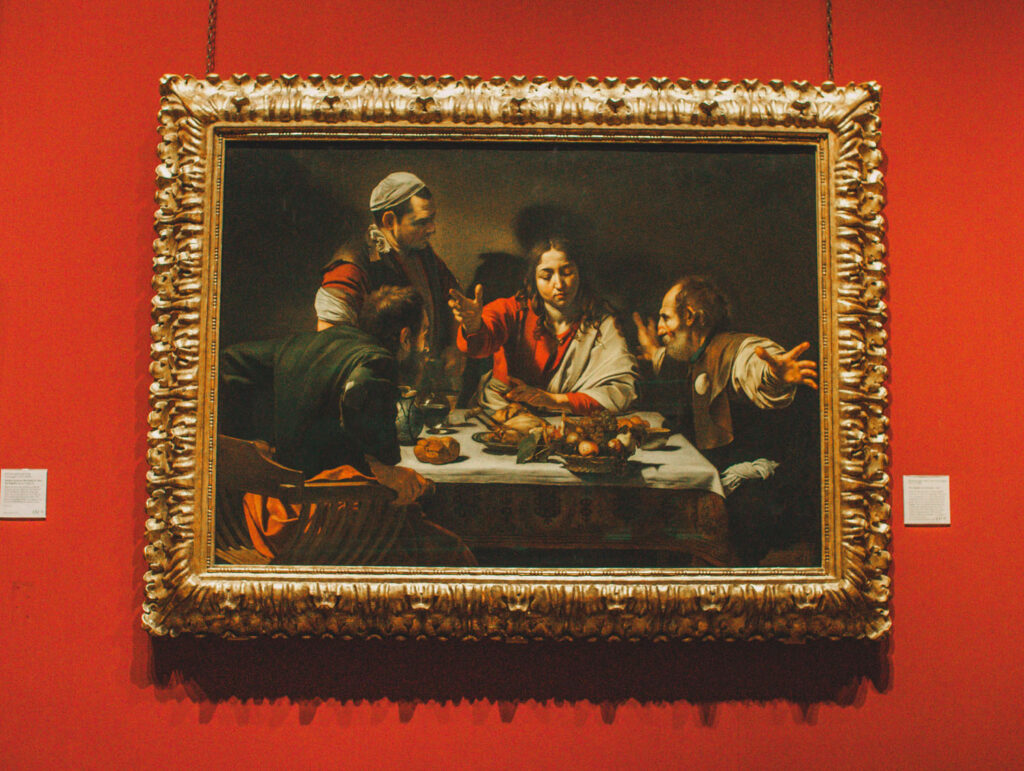
Caravaggio Process
Caravaggio’s mastery of chiaroscuro—the dramatic contrast between light and shadow—creates a powerful sense of depth and immediacy. The figures are illuminated by a soft, focused light that highlights their expressions and gestures while the background remains shrouded in shadow. This technique draws viewers into the scene, making them feel like participants in the miraculous moment.
Caravaggio used real-life models for his paintings, a practice that added a striking naturalism to his work. In The Supper at Emmaus, he paints Christ without a beard, which is unusual and adds to the disciples’ surprise at his identity. The realism and immediacy of the painting caused quite a stir when it was first unveiled.
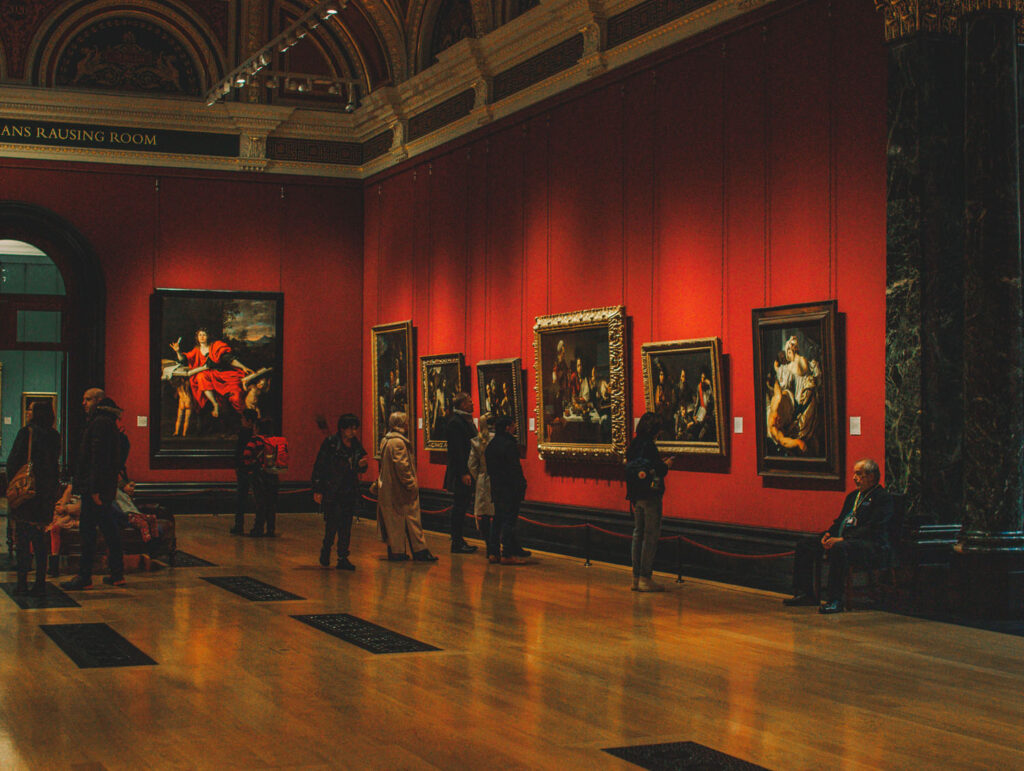
Room 34: The Fighting Temeraire by Joseph Mallord William Turner
Walking into Room 34, we are surrounded by stunning British landscapes. Joseph Mallord William Turner, commonly known as J.M.W. Turner, is one of Britain’s greatest painters who revolutionized landscape painting by elevating it to the level of historical and religious painting through his innovative use of light and colour. In masterpieces such as The Fighting Temeraire, Turner explored themes like the sublime forces of nature, maritime history, and the Industrial Revolution.
In this painting, the sun sets over the tranquil waters of the Thames, and the mighty HMS Temeraire, once a symbol of British naval power, is towed to her final berth to be broken up for scrap. Looking at the foreground, we can see a small, smoke-belching tugboat dragging the grand old warship, a stark contrast between the modern industrial age and the fading glory of the past. The Temeraire glows with ethereal, ghostly light, her towering masts and rigging silhouetted against the blazing sky. She appears almost spectral, embodying her illustrious past’s pride and sorrow.
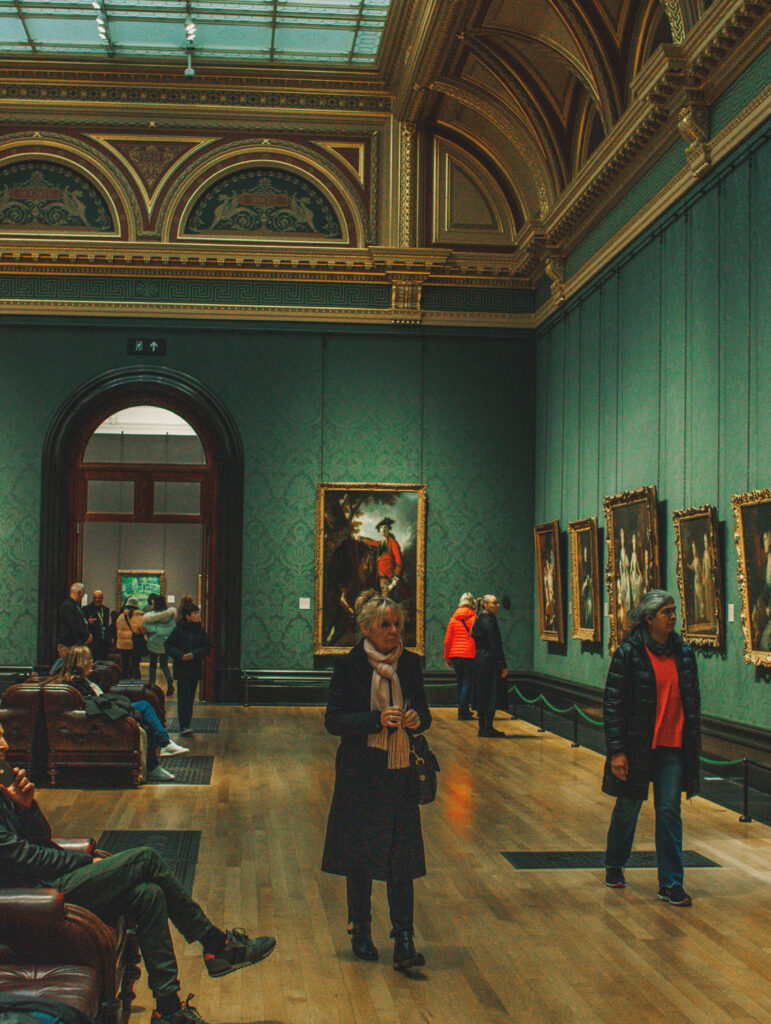
Turner’s masterful use of light and colour transforms the scene into a vivid spectacle. The sky is a riot of warm oranges, reds, and yellows, blending seamlessly into twilight’s cool blues and purples. The setting sun’s reflection dances on the water’s surface while the smoke from the tugboat curls into the fading light. The vastness of the sky dwarfs the ships below, emphasizing the grandeur and finality of the Temeraire’s last voyage.
Turner and Temeraire
The HMS Temeraire played a crucial role in the Battle of Trafalgar in 1805, where she fought alongside Nelson’s flagship, the HMS Victory. She became a national hero, and her name was synonymous with bravery and valour. Turner’s painting immortalizes her in a dignified farewell, paying homage to her storied past. The symbolism in the painting is rich and layered. The small, dark tugboat represents the relentless march of progress, towing the old warship toward her final fate. The blazing sunset reflects the end of the sailing era, while the rising moon on the left hints at the dawn of a new age.
Turner’s use of light creates a sense of drama and poignancy. The Temeraire is bathed in the golden glow of the setting sun, emphasizing her faded glory. The painting’s composition draws the eye from the tugboat to the Temeraire and finally to the vast expanse of sky, suggesting a journey from the material to the ethereal.

Room 41: The Water-Lily Pond by Claude Monet
Making our way to Room 41, we enter a room surrounded by some of the most mystifying paintings from world-renowned artists. But now, let us draw our attention towards the Water-Lily Pond by Claude Monet. Monet paints his lush garden at his beloved home in Giverny. Claude Monet lived in Giverny for over 40 years, and this was his artist’s sanctuary and creative haven. The lush gardens he meticulously cultivated inspired his later work, particularly the iconic Water Lilies series. Giverny allowed Monet to immerse himself in the beauty of nature and translate his unique vision onto canvas, making it central to his artistic legacy.
In the center of the painting, the curved green bridge is reflected in the calm water, framed by a cascade of willow branches that drape softly from above. The pond is a riot of colour, with water lilies floating like delicate jewels on the surface, their petals catching the sunlight in shades of pink, white, and yellow. The water shimmers with reflections of the sky and surrounding foliage, creating a mesmerizing interplay of blues, greens, and purples.
Monet’s loose, expressive brushstrokes lend a sense of movement and spontaneity to the scene, as if the lilies and leaves are gently swaying in the breeze. The layering of colours and textures adds depth and richness, drawing the viewer’s eye from the vibrant foreground to the dazzling light in the background. The painting exemplifies Monet’s fascination with capturing the fleeting effects of light and atmosphere.
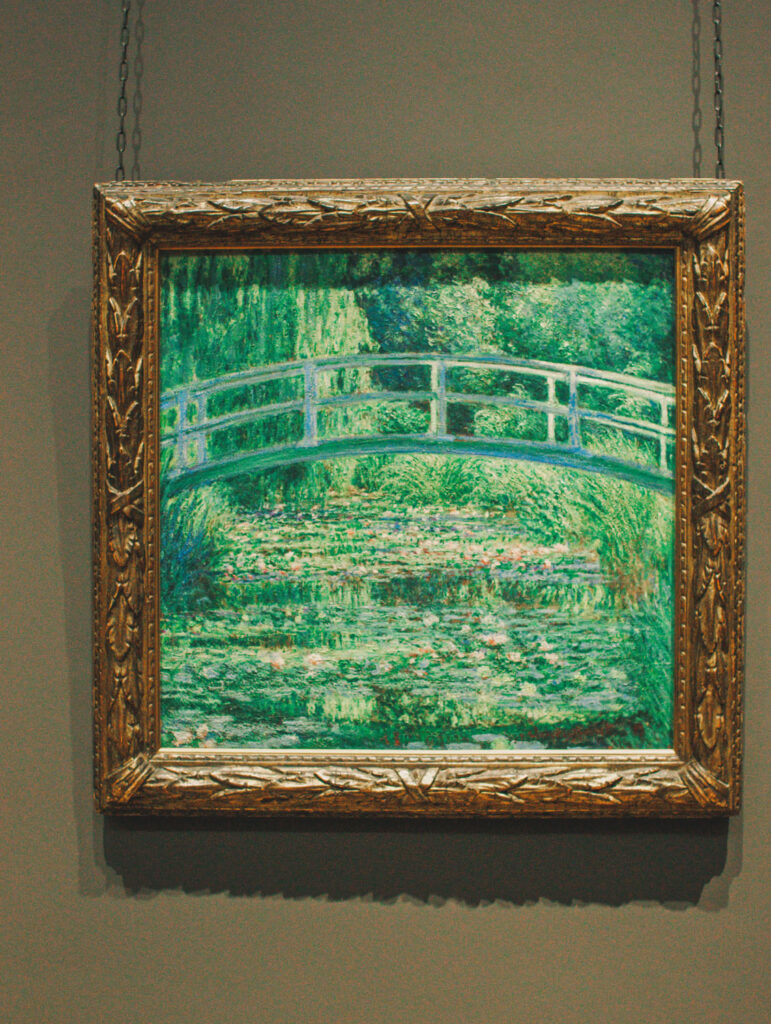
Room 41: The Umbrellas by Pierre-Auguste Renoir
Another painting in this room is The Umbrellas by Pierre-Auguste Renoir, a bustling, vibrant scene that immerses viewers in the everyday life of 19th-century Paris. We enter a crowded street on a rainy day, where a sea of umbrellas creates a kaleidoscope of grays and blues. The scene is alive with movement, yet Renoir’s deft use of colour and composition brings order and harmony to the chaos.
In the foreground, a stylish young woman in a striking blue dress and a neatly tied hat stands confidently amidst the crowd. She holds her umbrella with one hand while holding her daughter’s hand in the other. The little girl dressed in a matching blue coat and bonnet clings to her mother’s skirt, peering shyly out at the viewer.
In front of her, a woman caught without her umbrella balances a basket of fruit on her hip. Her serene expression and upright posture contrast the hurried, umbrella-clad figures around her. In the background are a group of figures, blurred and faceless in their hurry, each holding an umbrella. A well-dressed man in a bowler hat offers his arm to a lady while another figure raises his umbrella against the rain. The hurried, indistinct crowd creates a sense of depth and movement that draws the eye into the painting.
Colours in Renoir’s Artwork
Renoir’s use of colour is masterful. Cool blues and grays dominate the palette, punctuated by the bright splash of the woman’s blue dress and the warm tones of the child’s bonnet and basket. The umbrellas are painted in broad, loose strokes, creating a rhythmic pattern across the canvas that unifies the composition. The Umbrellas are unique in Renoir’s body of work because they reveal a transition in his style. The right side, with the serene woman and child, reflects his earlier, more Impressionist approach, characterized by softer lines and a luminous palette.
In contrast, the left side, with its crisper outlines and more muted colours, shows the influence of his later “Ingres period,” where he adopted a more classical style. The painting’s composition cleverly divides the scene into two halves, creating a visual dialogue between the Impressionist and classical elements. The crowd’s rhythmic movement, combined with the balanced contrast of colours, gives the painting a sense of unity and harmony despite the chaos of the rainstorm.
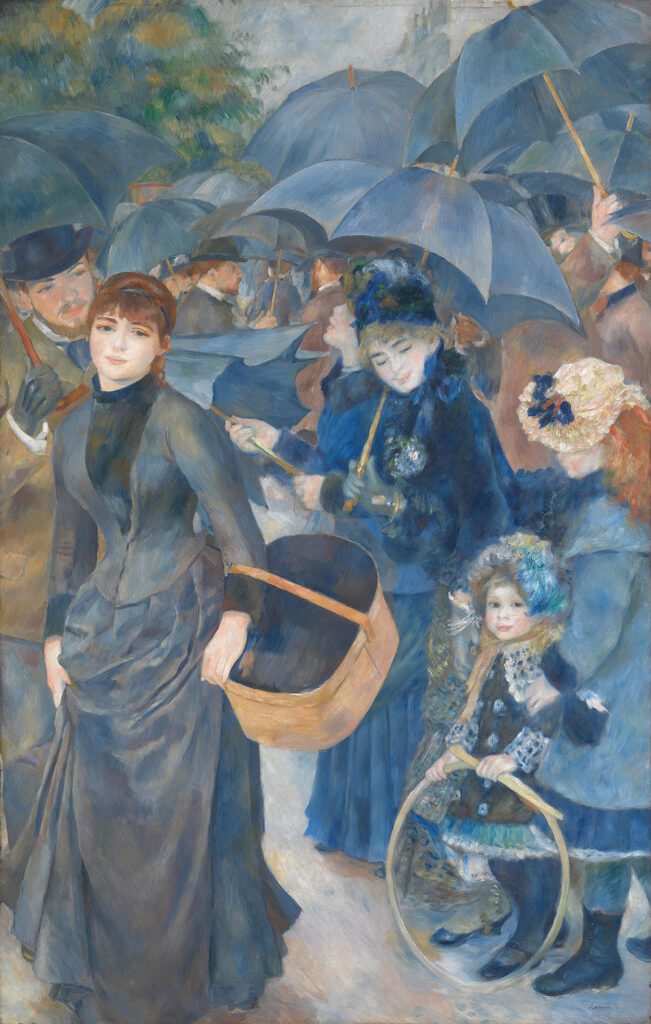
Room 43: A Wheatfield with Cypresses by Vincent van Gogh
Room 43, to the west, is one of the best collections of works of art from my favourite artist, Vincent van Gogh. There are so many different paintings from different periods of his life to see here, and while many people float to look at Sunflowers by Vincent van Gogh, I think there is so much more about the great artist to learn from the A Wheatfield with Cypresses. This painting brings you into Provence, stepping into a golden wheatfield under a swirling summer sky, where cypress trees and rolling hills frame the scene, creating a vivid snapshot of the French countryside where Van Gogh spent the last few years of his life.
In the foreground, the rippling wheat undulates in shades of gold and ochre, leading the viewer’s eye toward a trio of cypress trees that stand tall and dark against the bright sky. The distinctive, flame-like shapes of the cypresses are echoed in the swirling clouds above, creating a rhythmic interplay of movement and colour. The backdrop of the Alpilles mountains adds depth and drama to the composition.
Van Gogh’s characteristic brushwork is evident in the bold, rhythmic strokes that convey the movement of the wheat and the swirling sky. His use of contrasting colours—bright yellows against deep greens and blues—creates a striking visual impact and captures the intensity of the summer heat. A Wheatfield, with Cypresses, was painted in 1889 while van Gogh lived at the Saint-Paul-de-Mausole asylum in Saint-Rémy-de-Provence. Despite his troubled mental state, this painting reflects a sense of optimism and vitality, showing his deep connection to the landscape around him.
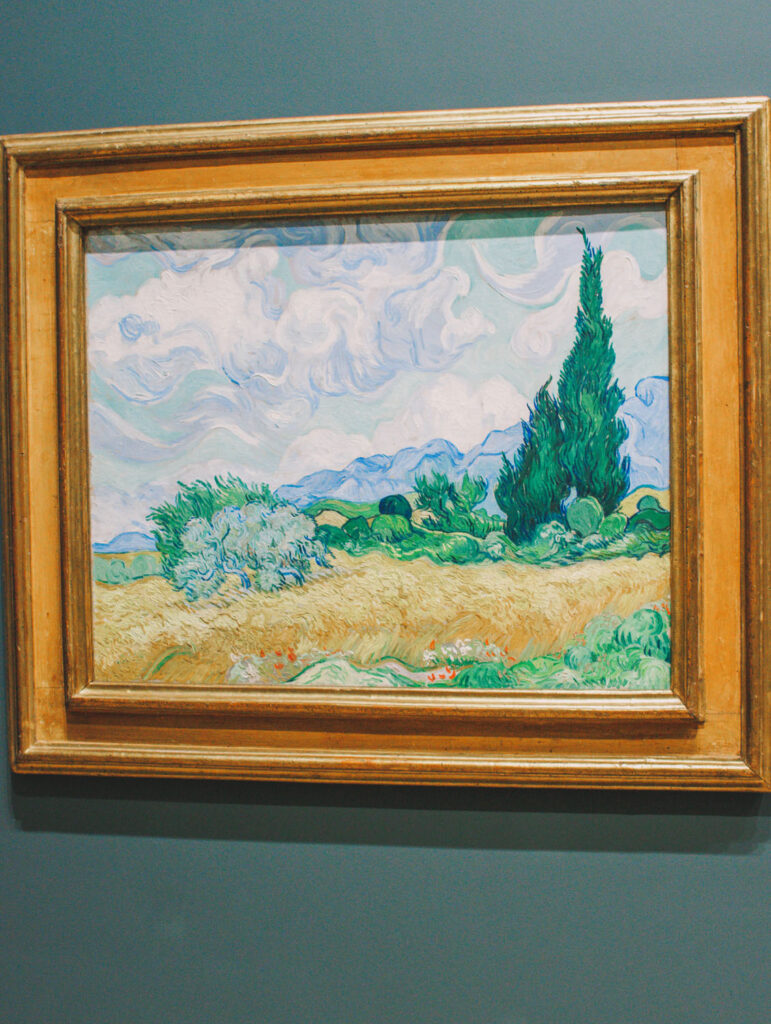
Room 43: Bathers at Asnières by Georges Seurat
Also found in this room is Bathers at Asnières by Georges Seurat. Seurat was only 24 when he painted Bathers at Asnières, his first central canvas. Despite its groundbreaking technique, the painting was rejected by the Paris Salon and instead exhibited at the Groupe des Artistes Indépendants. Seurat’s technique, known as pointillism, is characterized by applying tiny dots of pure colour, which blend together when viewed from a distance. This creates a luminous, shimmering effect that brings the scene to life. The river glistens with blue, green, and white reflections while the dappled sunlight plays across the grass and the bathers’ skin in delicate shades of yellow, orange, and red. Today, it is considered a masterpiece of early Neo-Impressionism. An important message to everyone is never to accept defeat when faced with rejection.
In the foreground, a young man sits on the riverbank, his feet dipped into the cool water as he gazes across the river. Beside him, a boy lies on his stomach, idly making noises with a reed. A shirtless man in a straw hat rests his chin on his hands, watching the steamers pass by.
Further to the right, a group of boys wade and swim in the river, their laughter echoing through the warm summer air. In the background, factory chimneys rise against the blue sky, hinting at the industrial activity of Paris just beyond this tranquil scene. The soft silhouettes of boats and bridges blend into the hazy horizon, creating a seamless transition between the natural and urban landscapes.
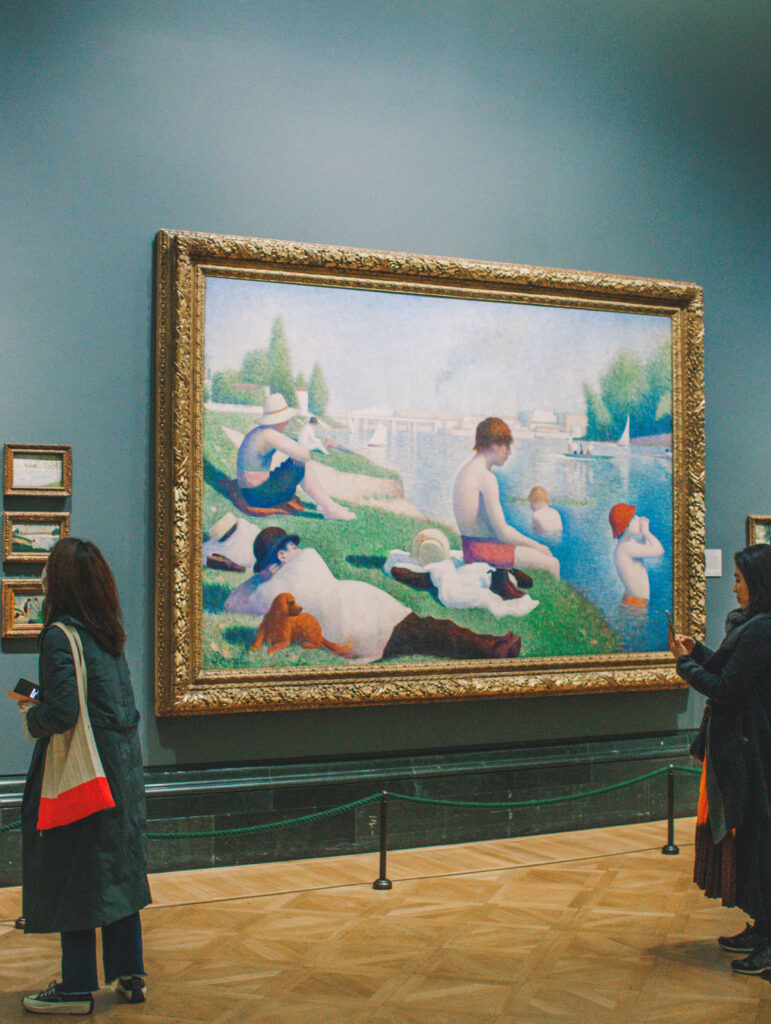
Room 45: The Execution of Lady Jane Grey by Paul Delaroche
The last painting we will see today is my favourite: Paul Delaroche’s The Execution of Lady Jane Grey. It is a haunting and poignant portrayal of one of English history’s most tragic events. Lady Jane Grey, known as the “Nine Days’ Queen,” was an English noblewoman who briefly occupied the throne of England in July 1553. Born into a politically influential family, she was manipulated by ambitious relatives and political figures who sought to prevent the Catholic Mary Tudor from ascending the throne. Following the death of Edward VI, she was declared queen under a dubious will, but her reign lasted only nine days before Mary gathered enough support to depose her. Despite her reluctance to claim the crown, Jane was charged with high treason and executed in February 1554 at the age of 16. Becoming a tragic symbol of political intrigue and the turbulent Tudor succession.
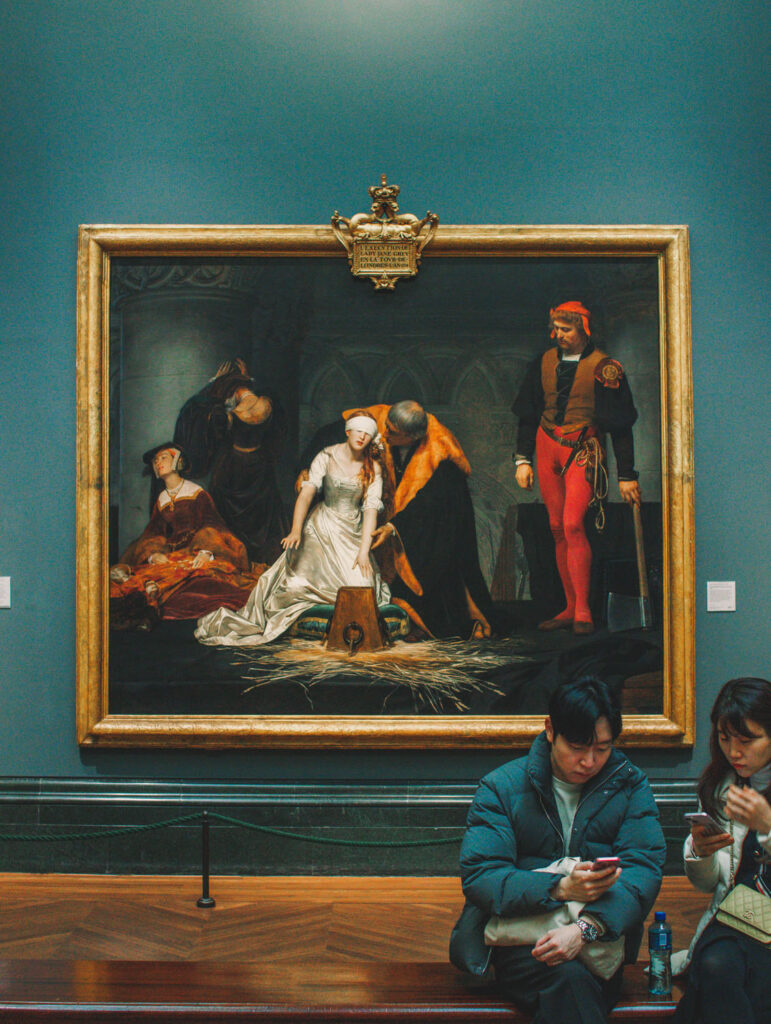
In this painting, we enter a dimly lit execution chamber, where Lady Jane Grey, the “Nine Days’ Queen,” prepares to meet her fate. The scene is shrouded in darkness, illuminated only by the soft, focused light that falls upon Jane, highlighting her innocence and vulnerability. In the center of the composition, Lady Jane stands blindfolded, her delicate hands groping for the execution block.
She is dressed in a simple white gown that glows against the sombre background, symbolizing her purity and youth. She expresses resignation and fear but maintains quiet dignity as she kneels before the block. Behind Jane, a woman—perhaps her lady-in-waiting—buries her face in her hands, unable to watch the tragic scene unfold. Another attendant faces the wall, unable to face the event. To the right, the executioner waits. His axe rests beside him, partially hidden in shadow, adding to the ominous atmosphere.
Delaroche’s Approach
The stark simplicity of the setting—a stone floor covered in straw and dark, blurred walls—focuses all attention on the figures and their emotions. Delaroche’s masterful use of light and shadow creates a dramatic chiaroscuro effect, emphasizing the tragic tension of the moment. The soft light that bathes Jane’s figure enhances her ethereal beauty and innocence, while the shadowy surroundings evoke the grim reality of her fate. Paul Delaroche painted The Execution of Lady Jane Grey in 1833, almost 300 years after her death. The painting was considered lost for many years after being removed from public display in the mid-19th century, only to be rediscovered and restored in the 1970s. Today, it remains one of Delaroche’s most famous works.
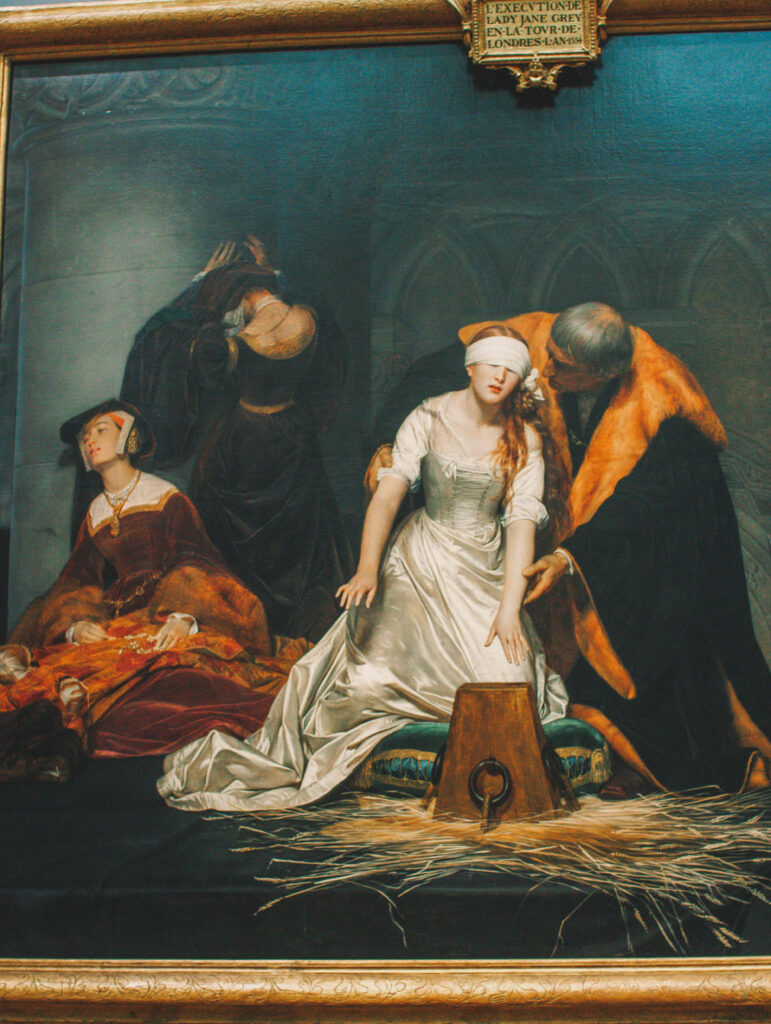
The National Gallery in London offers a captivating journey through centuries of artistic genius. From the soft, shimmering brushstrokes of Monet’s Water-Lily Pond to the dramatic contrasts in Caravaggio’s Supper at Emmaus and the poignant tragedy of Delaroche’s The Execution of Lady Jane Grey, each masterpiece tells a story that resonates across time, offering a glimpse into the rich history of art. With this self-guided tour, you’ll discover the gallery’s most iconic works and hidden gems, uncovering a rich tapestry of human creativity that makes the National Gallery such a treasure trove of art.
Happy Travels, Adventurers
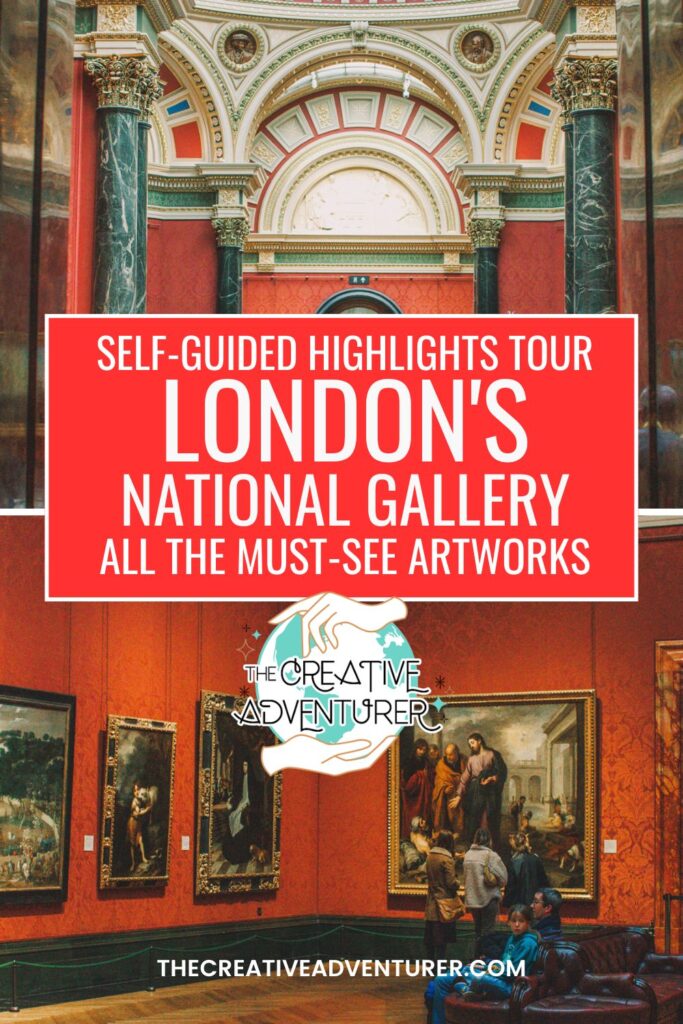

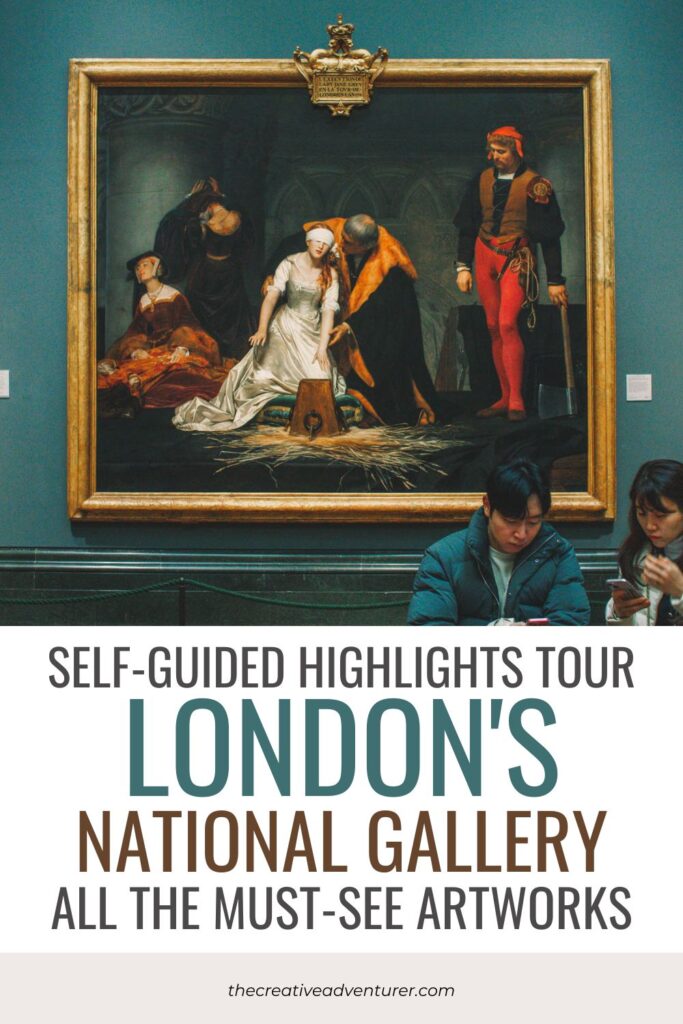


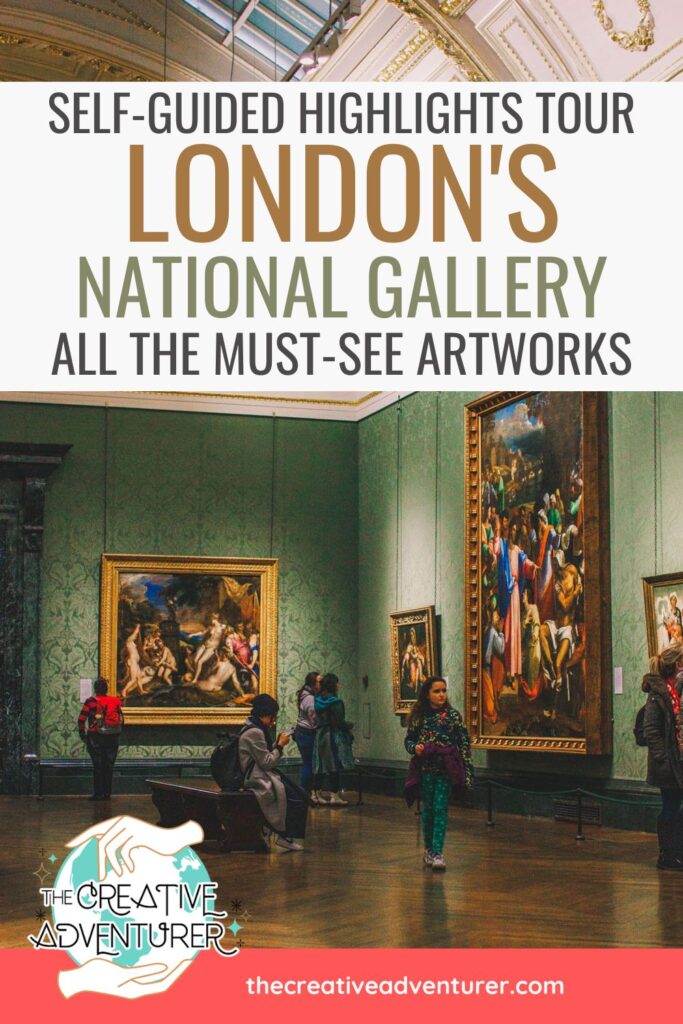




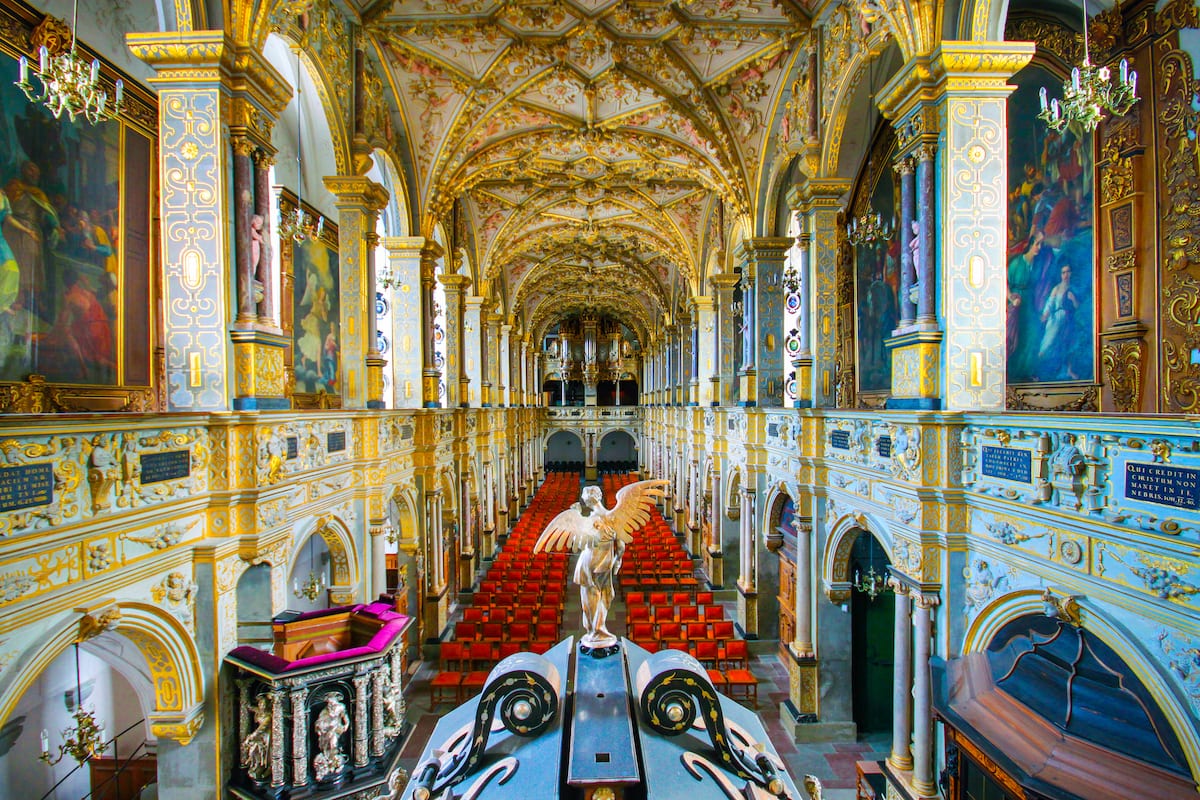
Leave a Comment